Nougat de Montélimar in detail.
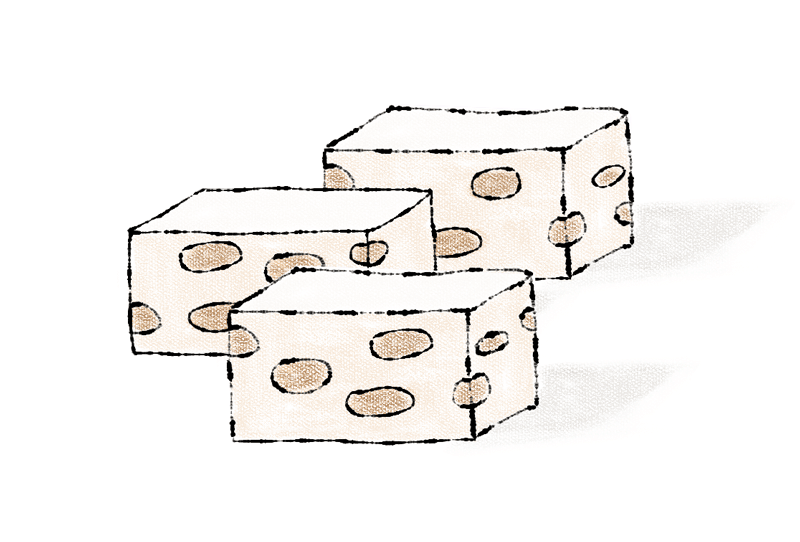
French confiserie and, in particular, making Nougat de Montélimar (a.k.a., nougat blanc, or torrone in Italian) has become a minor obsession and happy diversion of mine. At every step of the process the substances involved are quite beautiful, and the end result has a sublime taste and texture truly unlike anything else. Its production is a mysterious, almost alchemical, exercise, and I commend it highly to the culinary hobbyist, notwithstanding its many subtleties and technical challenges.
For all its nuance, nougat is in fact a very simple concept; it is little more than a honey-impregnated meringue, consisting of three core ingredients: glucose, honey, and egg whites. I provide what I consider to be the canonical recipe, but I also provide a conceptual discussion of how the process works such that it is possible to alter variables in the end product—hardness, loft, sheen, texture, etc.—in order that you can make all the different forms you might ever care to.
The Back Story
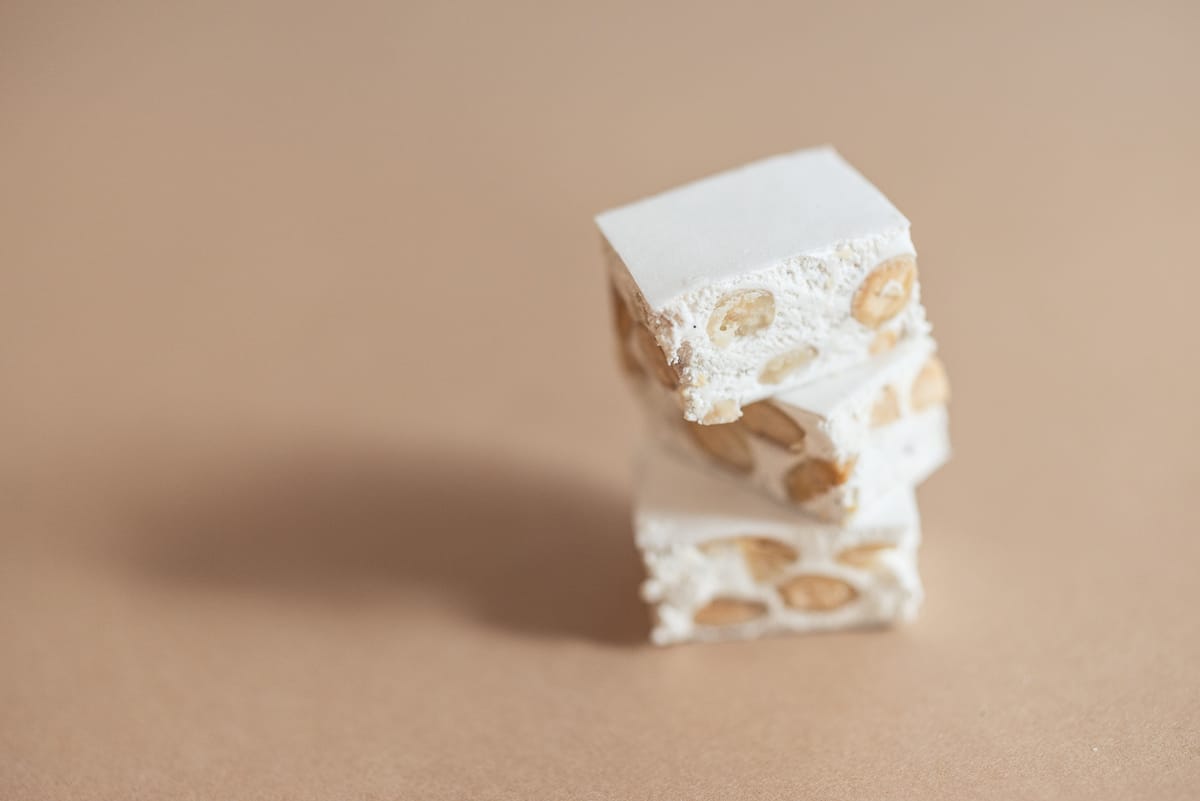
I have been experimenting with nougat for years now, and I've easily made more than 50 batches—varying such details as temperature, inclusions, doctoring agents, albumen sources, etc. I began with Flora Lazar's recipe, adapted from the French Pastry School, and demonstrated in this slightly quirky video. I modified that recipe in several ways: to be a bit softer, to include vanilla flavor, to show off the wafer paper better, etc., but I still wasn't entirely satisfied with the level of control it offered and I didn't understand why the properties of my batches sometimes varied significantly, even though I felt I had followed the recipe assiduously.
However, in 2013 I discovered the magisterial Chocolates and Confections: Formula, Theory, and Technique for the Artisan Confectioner by Peter Greweling of the Culinary Institute of America, which not only provided the starting point for an improved recipe but, more importantly, helped me understand some of the principles underlying how the culinary magic operates. Further eludication was offered by my recent reading of Advanced Bread and Pastry by Michel Suas.
Other references:
- History and manufacture of nougat (YouTube, in French)
- Examples of artisinal nougat manufacture (also in French): Moulin Bleu, Jonquier, Fouque
The below is the culmination of my researches and experimentation.
Equipment
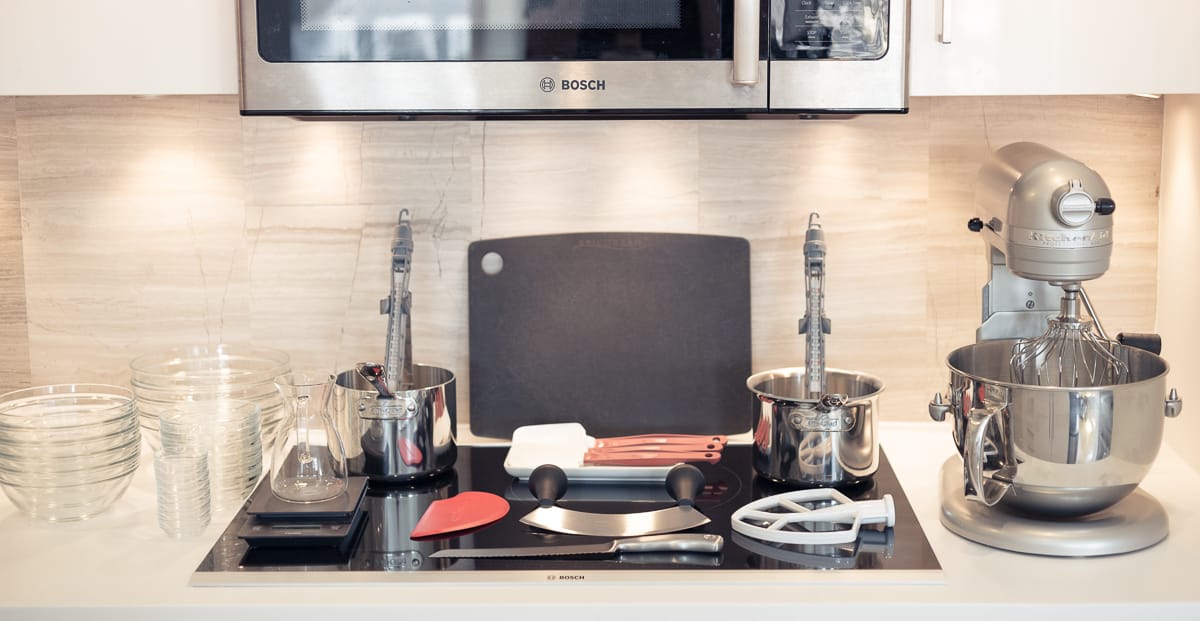
I've put some effort into experimenting with different tools. I have provided below links to the precise equipment I use myself and information on how I lay out my workspace, based on the results of those adventures—and misadventures.
Mise en place bowls
Duralex mise en place bowls (France)

Saucepan
I like these because they have a lot of steel in them, which makes heating up on my induction range faster. For the sugar/glucose mixture particularly, you want to heat the syrup as rapidly as possible to avoid burning the sugar and ending up adding an ugly brown tint to your nougat. You also want a saucepan with high sides and a small diameter, as the All-Clad 2-quarts have. This makes it possible to submerge the temperature probe properly into the liquid without having to rest it against the bottom of the pan. In wider-diameter pans the liquid is too shallow to allow an accurate reading.
2 x All-clad 2-quart saucepan (All-Clad, USA)
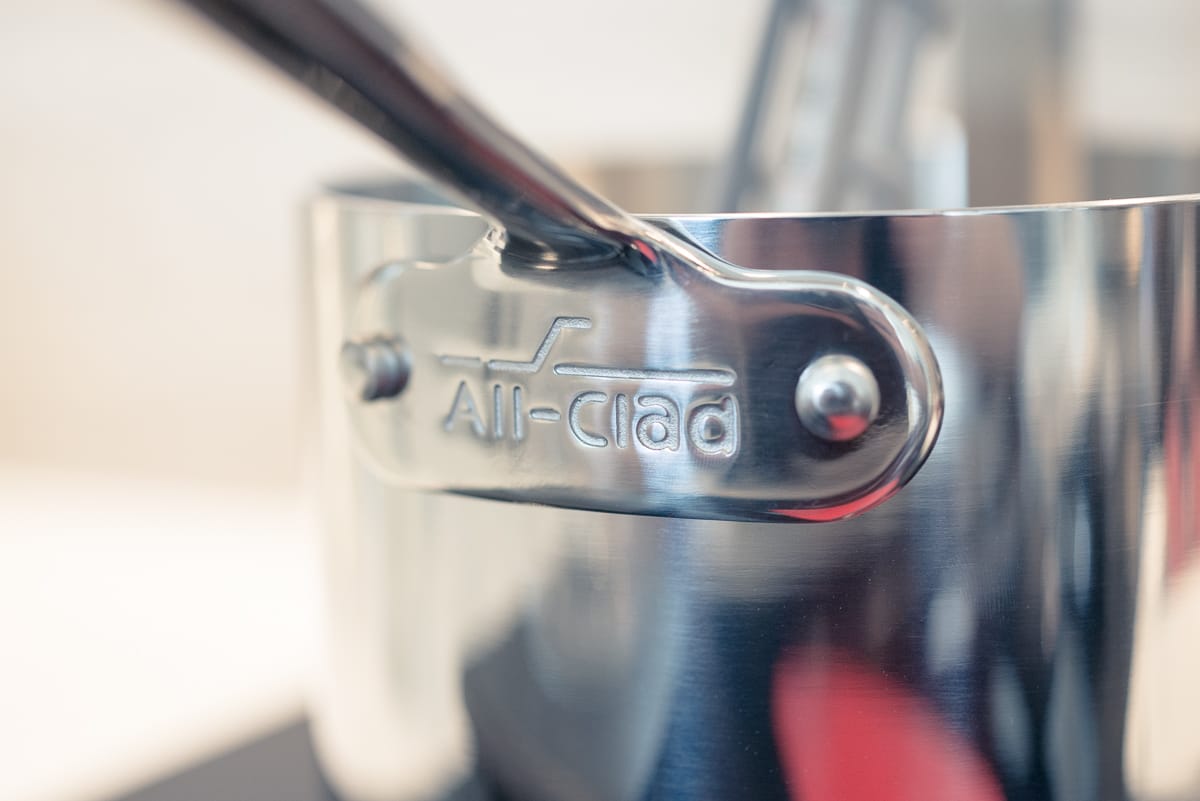
Confectionery thermometer
I have experimented with many. These don't require calibration, are dishwasher-safe, and are easy to read because of their large graduations. Matfer also sell a clip for attaching the thermometer housings to the wall of your saucepan.
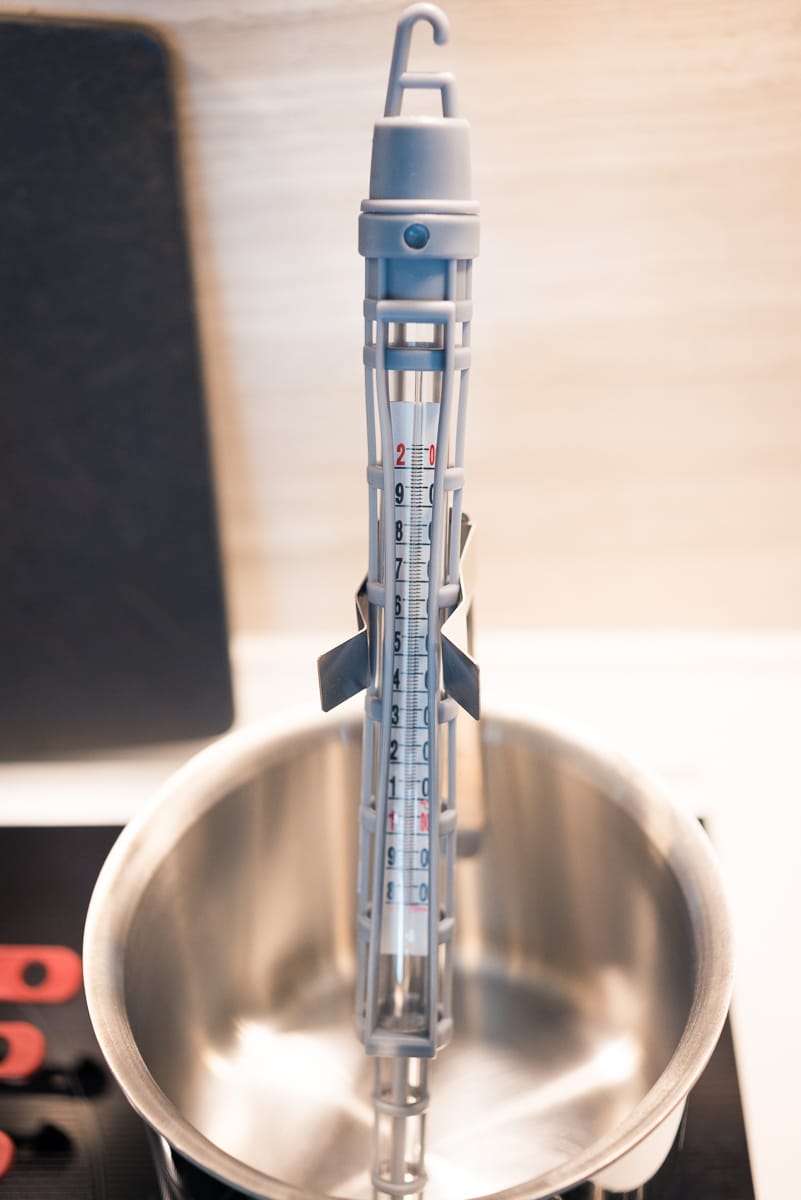
Precision scale
This precision scale from Hario, Japan is one of the best I've found. Unlike lesser units, the Hario uses 0.5g increments and actually smoothly registers weight changes as you gradually stream continuous substances like glucose syrup onto the balance. I have used home digital kitchen scales that, while fine at measuring a single discrete object placed on them, simply aren't up to the task of continuously registering gradual weight changes. They would tend instead to jump up in large increments, causing me to overshoot the intended weight target. The Hario is intentionally built with high fidelity/granularity in mind.
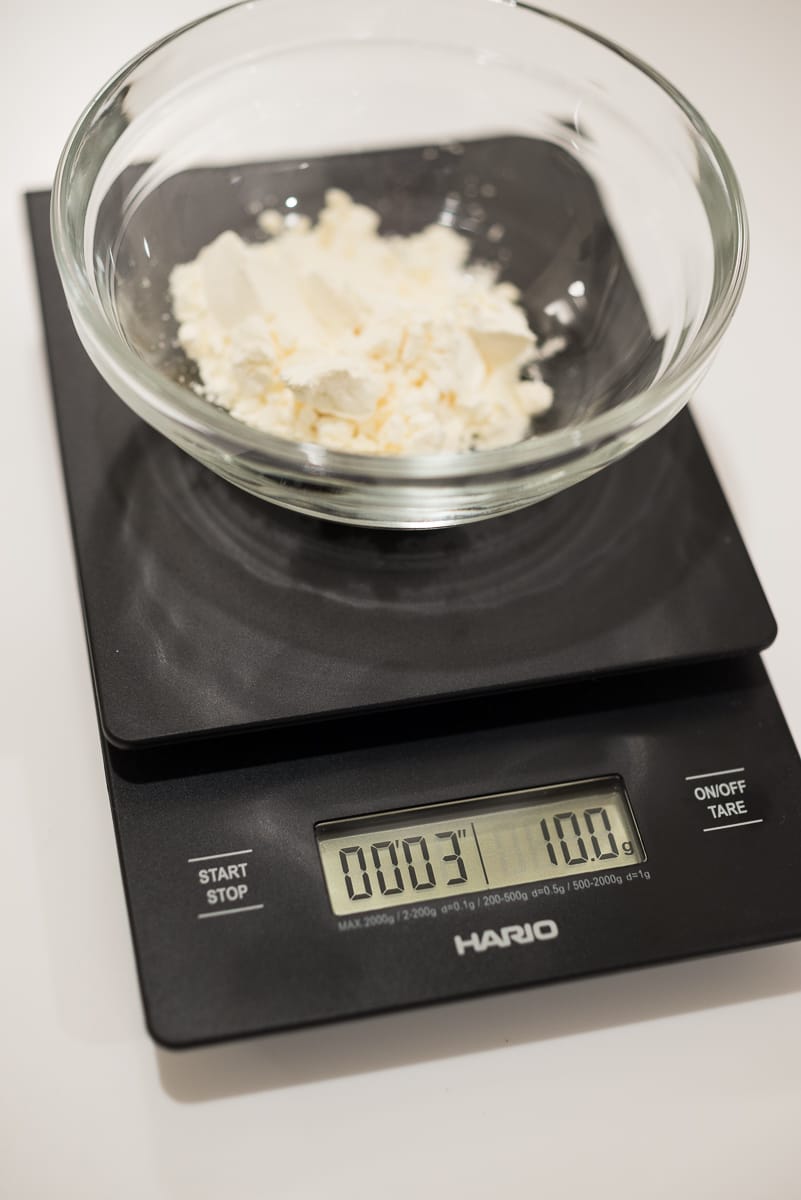
Mixer
6-quart stand mixer (KitchenAid, USA) Given the high viscosity of nougat once the sugar is added, you'll fare much better with a heavy-duty pro mixer like the 6-quart than the lower-end KitchenAids.
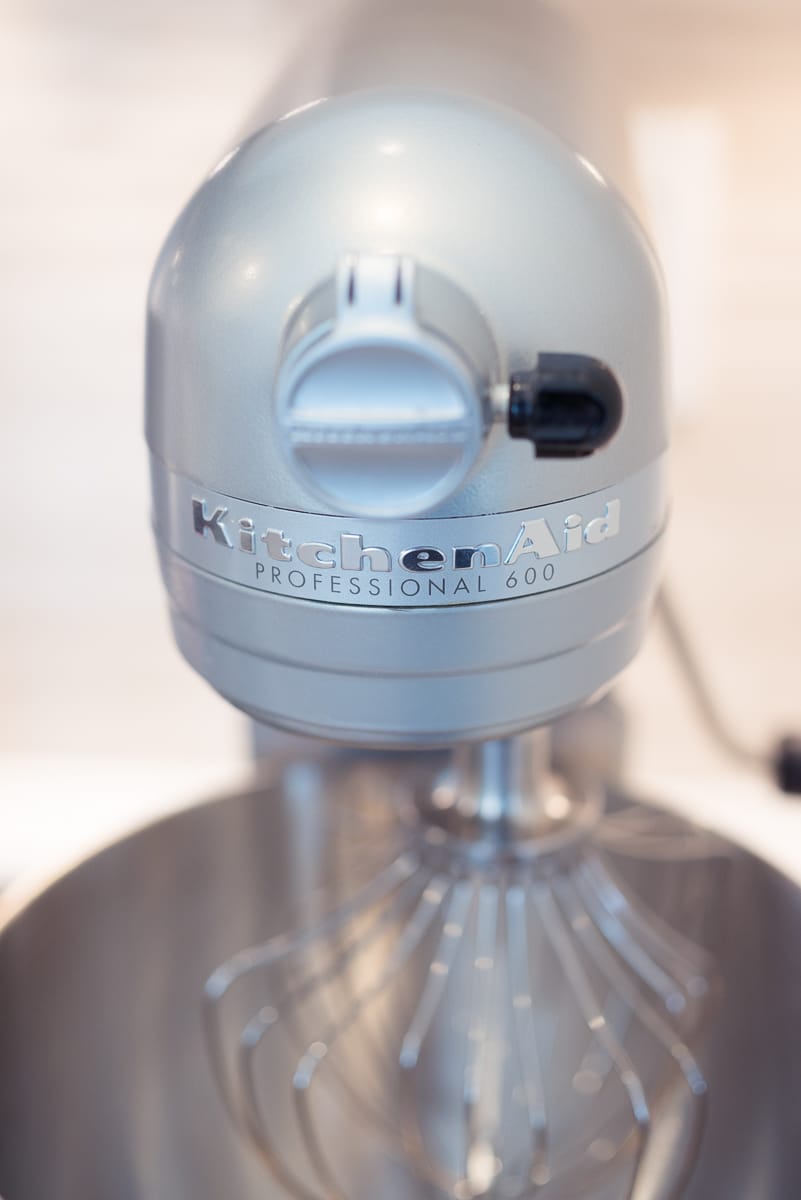
Cutting board
Epicurean, USA. These excellent cutting boards are dishwasher safe (nougat dissolves completely) but not slippery like other dishwasher-safe cutting boards, so the wafer paper stays in place.
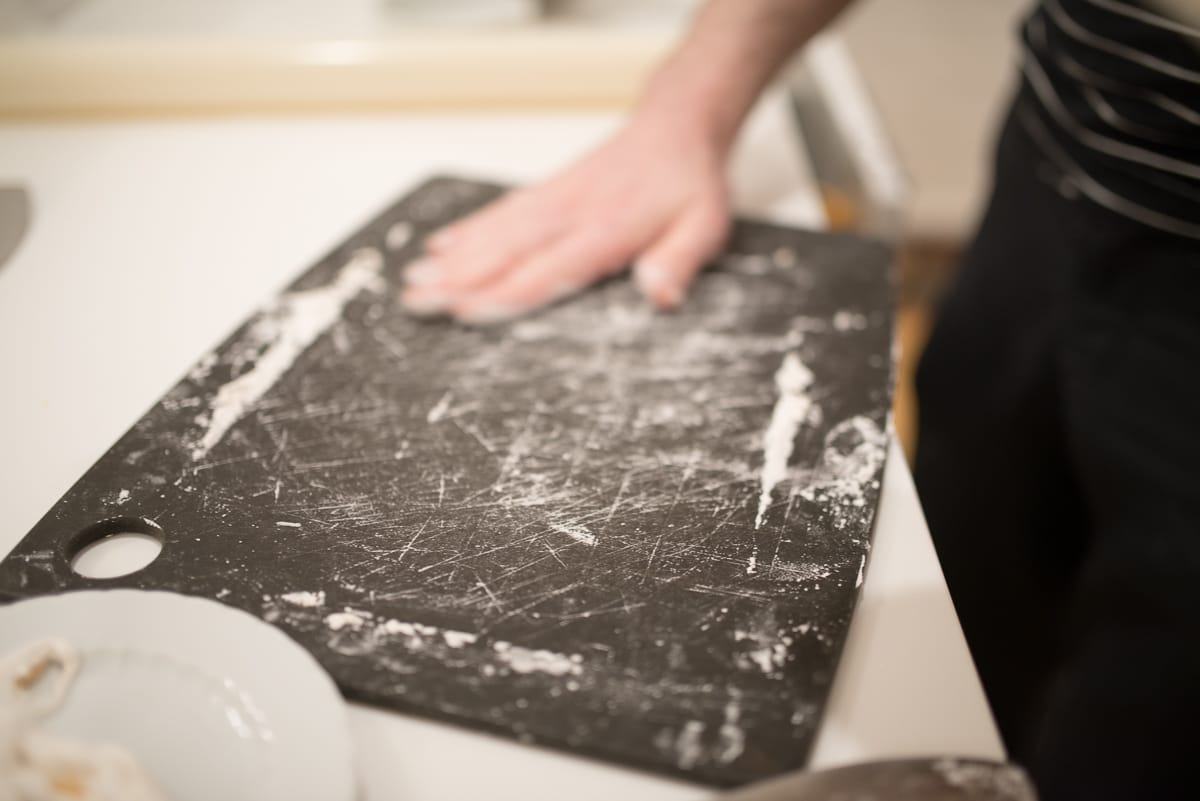
Cutting tools
9" mezzaluna and 9" serrated knife (Wüsthof, Germany) The mezzaluna is for making incisions to create the long strips. The serrated knife is for cutting the long strips into smaller bite-size pieces, should you choose to do so.
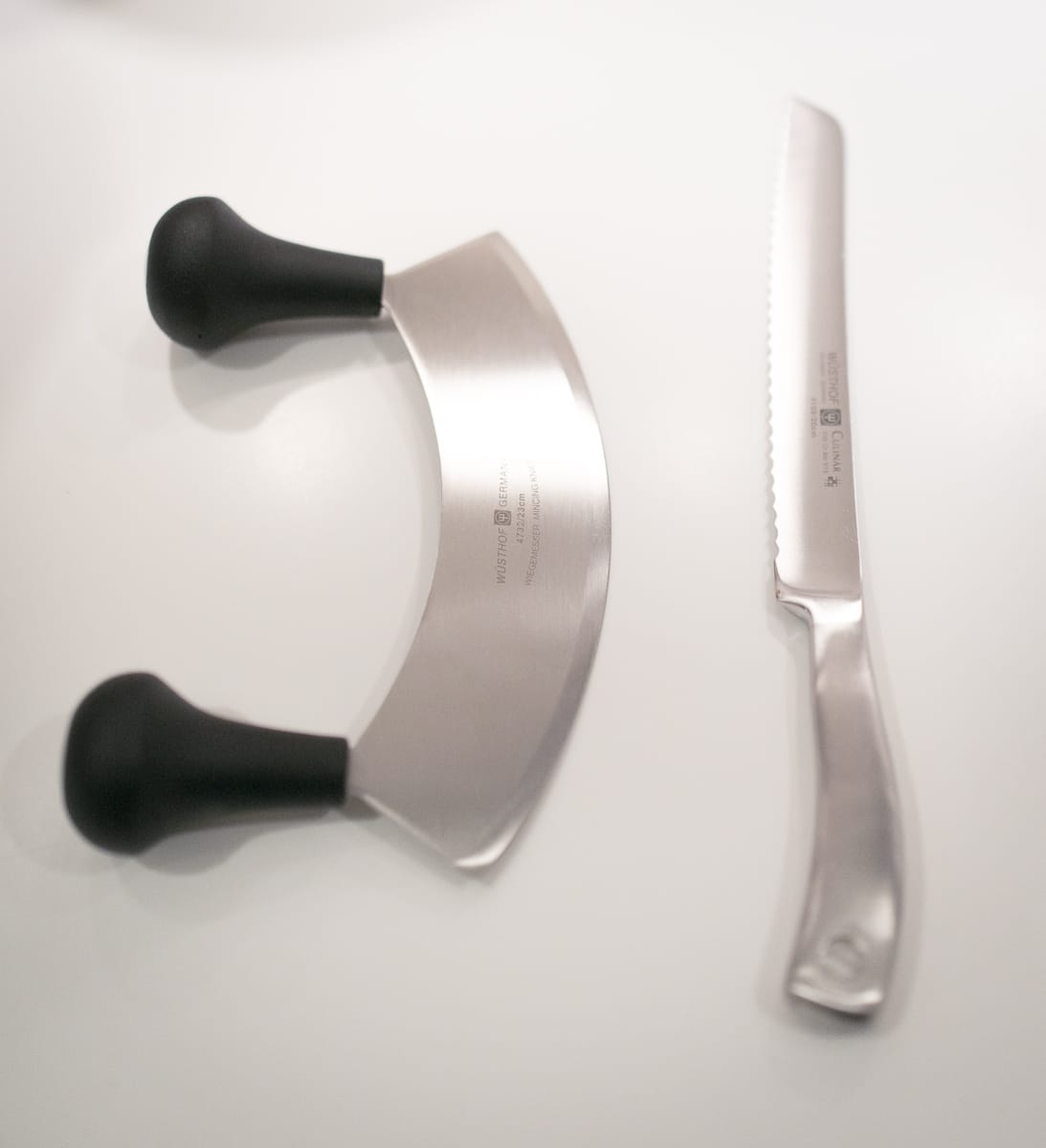
Rolling pin
Matfer Bourgeat, France. I would strongly advise against using a wooden rolling pin, as nougat will adhere to it immediately. This and the other (nylon) rolling pin made by Matfer have non-porous surfaces that make adhesion less likely and cleaning much easier.
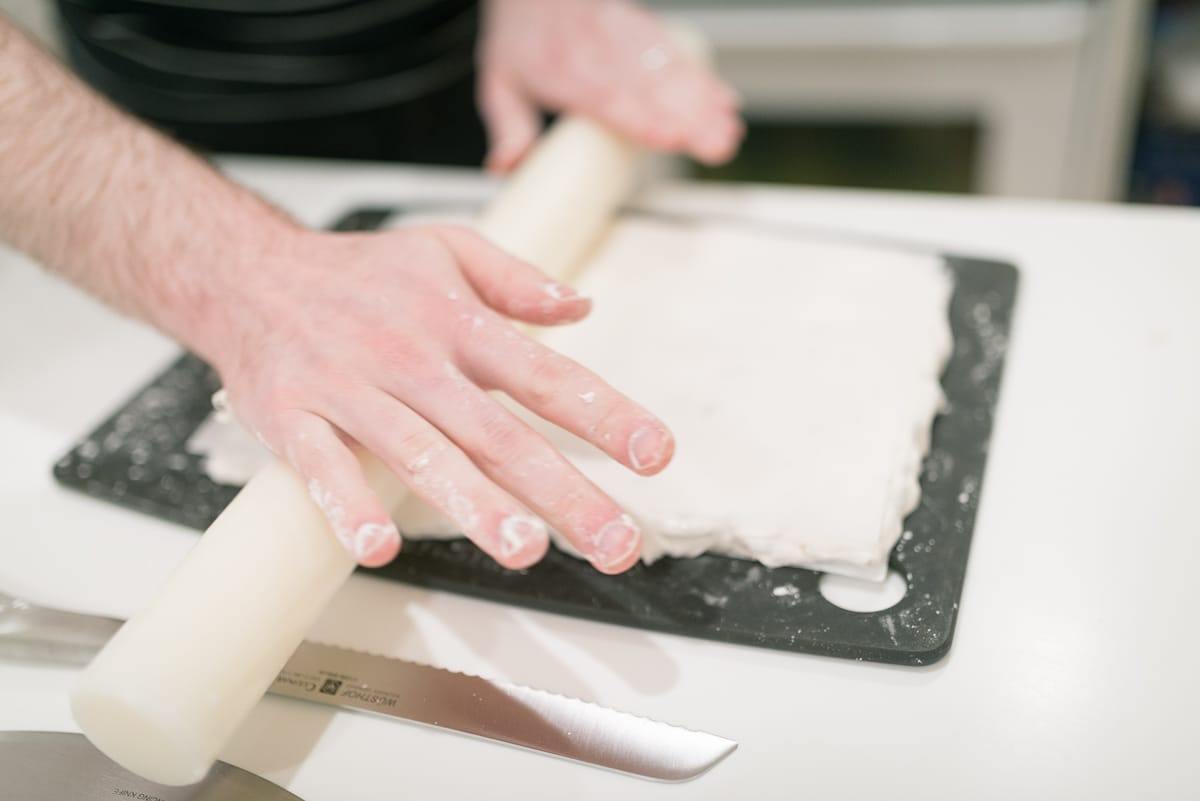
Scraper
iSi bowl scraper Perfect for scraping out a KitchenAid professional mixer; it precisely traces along the round contours of the bowl, and the pointed edge deftly pokes nougat out of the beater attachment's holes.
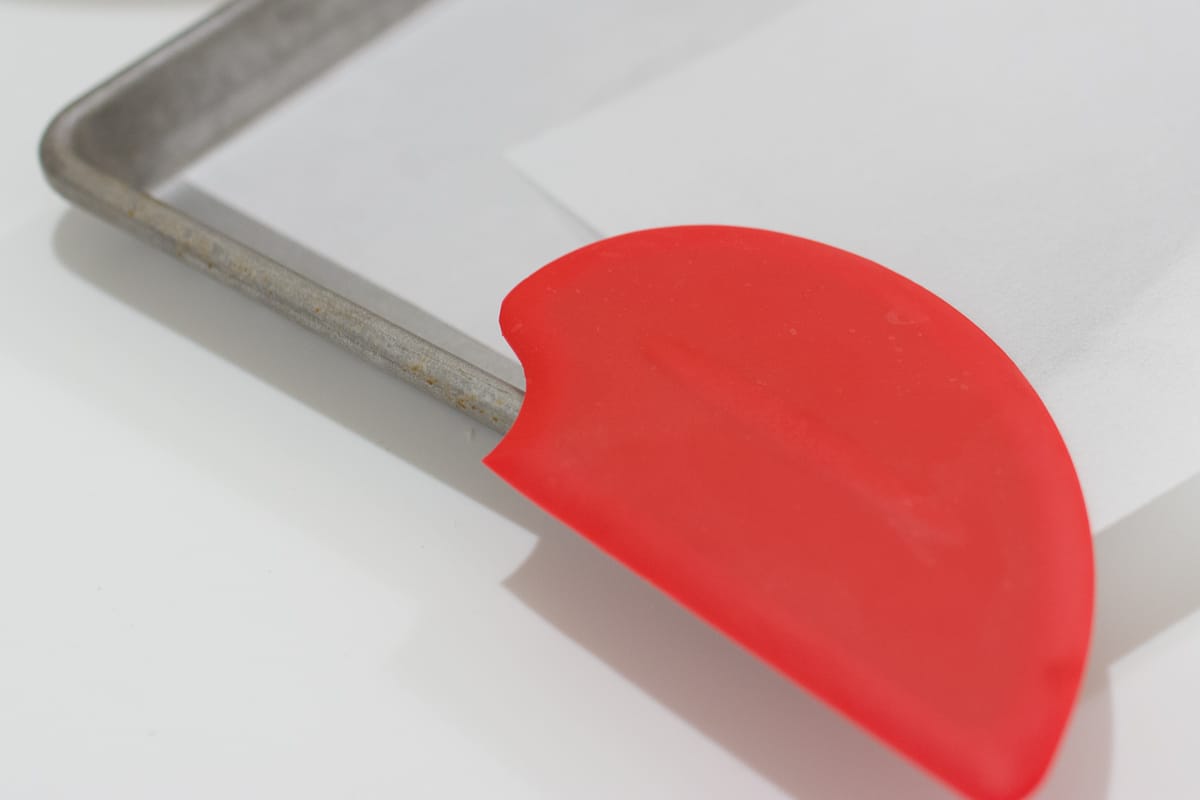
Spatulae
Any heat-resistant silicone spatulae will do. I like the commercial ones from Rubbermaid.
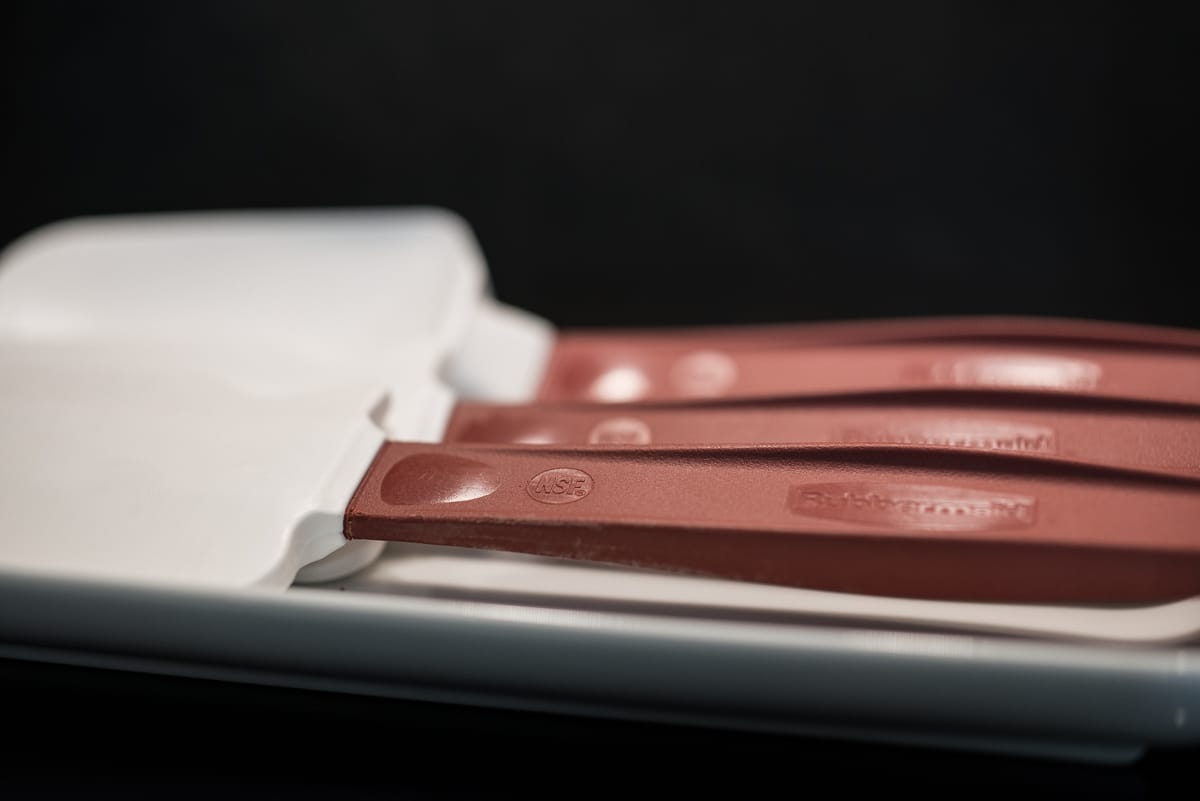
Mixing tools
- coated stand mixer beater attachment (KitchenAid, USA) The coated version cleans more readily in the dishwasher.
- stand mixer wire whip attachment (KitchenAid, USA) The 11-wire whisk I've linked to is far more efficient at quickly lofting up egg whites than the one that comes with the 6-quart KitchenAid mixer.
- hand wire whisk
Preparing Your Workspace
For precision and accuracy, this recipe (like most professional confectionery recipes) uses gram weights rather than volumetric measurements. You should measure out all ingredients in advance using the mise en place method and a precision scale (see equipment links above).
It's a race against the clock as soon as the heated sugar mixture is added to the egg whites; with each passing minute the nougat becomes less pliable. You'll thus want to get everything lined up and in order for the tasks that come after.
If you're using cocoa butter, it ought to be pre-melted and ready to be poured into the mixture. The microwave is an easy way to do this.
You ought also to have your inclusions close at hand, kept warm in a toaster oven at around 50° (120°F)
Your tools for working the hot nougat also need to be prepped. Nougat is very sticky—insanely so if you're opting to forgo the cocoa butter. Covering your hands and tools in corn starch helps keep things from getting glued inextricably together. Lay out one sheet of wafer paper on the cutting board, and keep the other nearby.
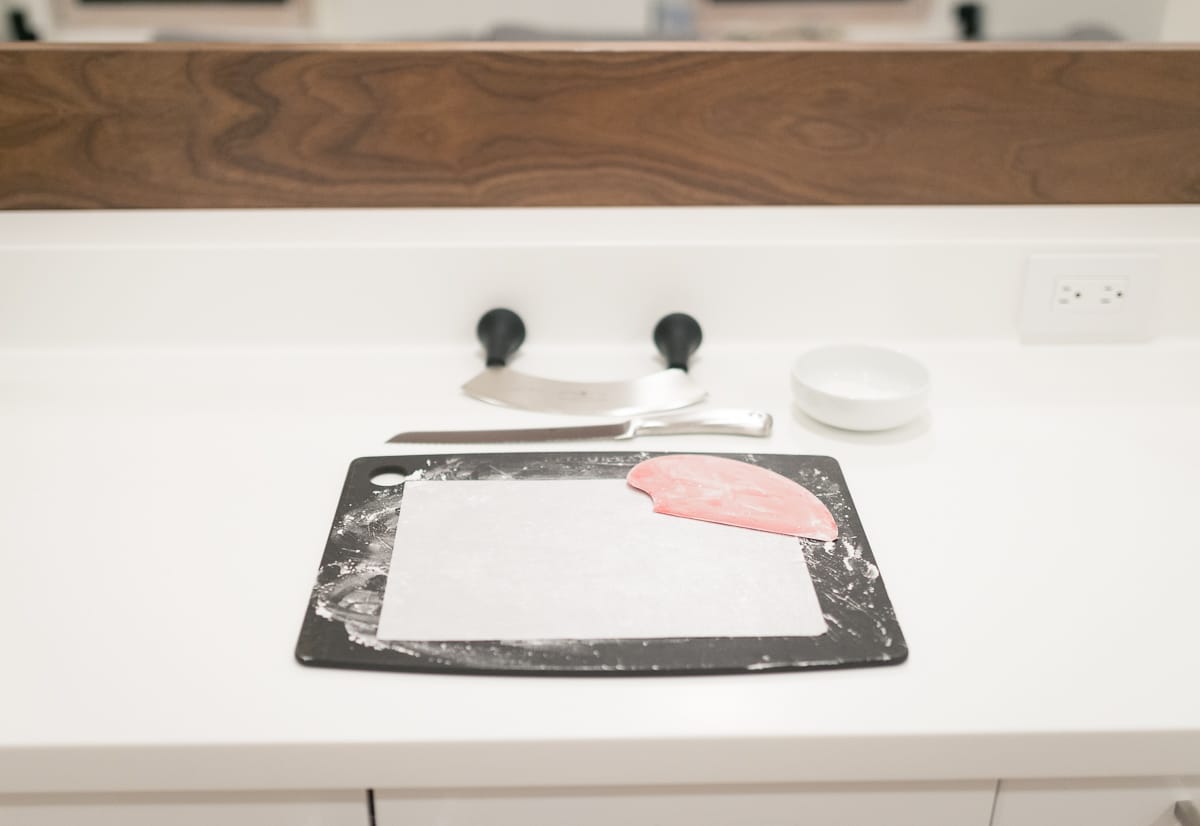
Have a bowl of cornstarch nearby for quickly re-coating things, especially your hands, in the heat of the moment. Dust your bowl scraper and cutting board in cornstarch also.
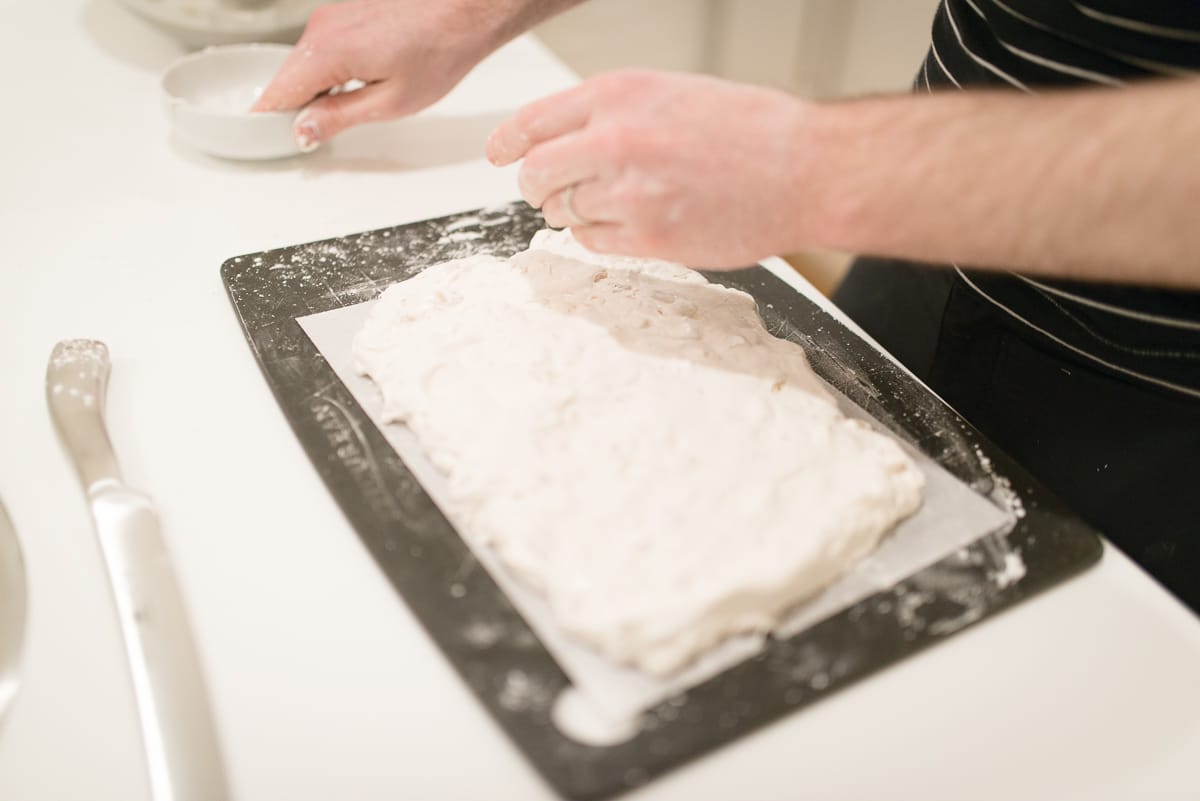
You'll also want to have spatulae (in case you need to scrape down the sides of the mixer bowl) and the flat beater attachment at the ready near the mixer.
Theory and variations
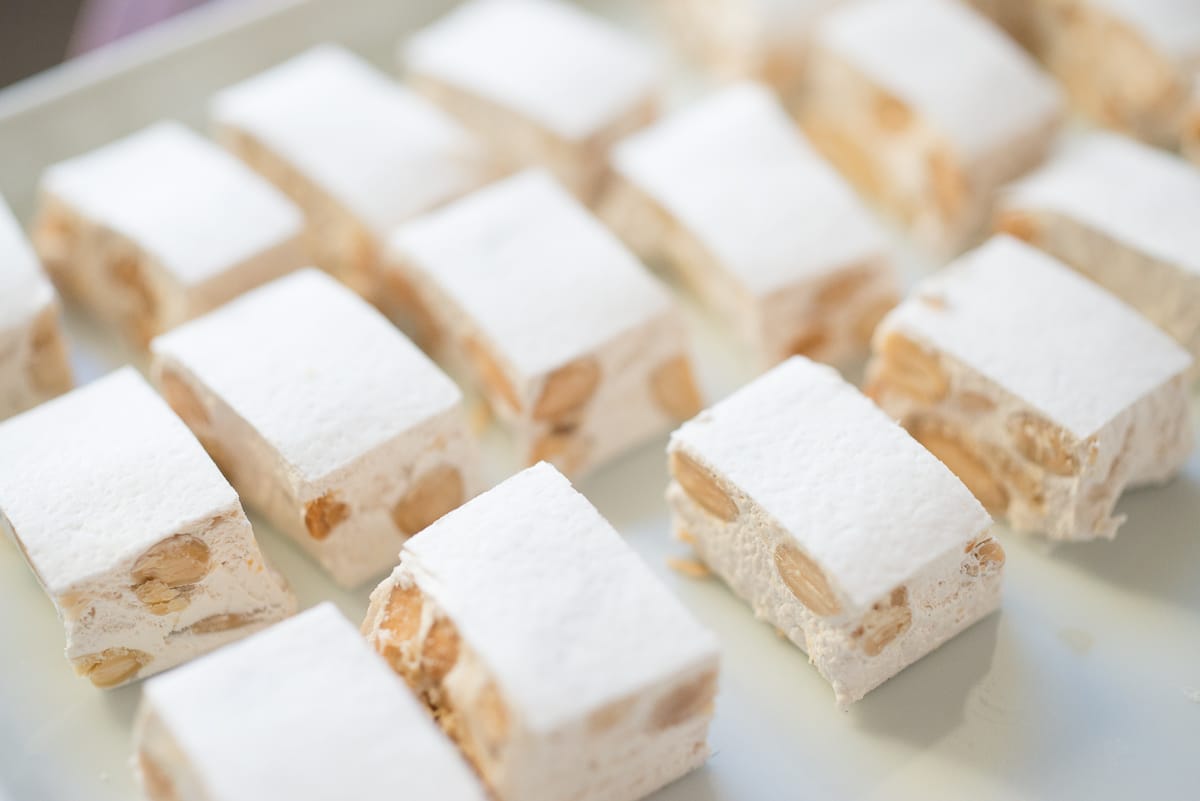
In Chocolates and Confections: Formula, Theory, and Technique for the Artisan Confectioner , Greweling classifies nougat as an aerated confection, along with marshmallow and divinity (basically the Southern American version of a soft nougat, sans honey). There are various ways of aerating candy; nougat uses mechanically whipped albumen.
My approach uses a particular combination of ingredients and temperatures, all chosen for a particular end result (a brightly-colored, soft, fluffy texture and subtle flavoring that highlights the quality of the simple ingredients used). In this page, I explain the rationale for my variations, and give tips for those wishing to alter particular dimensions of the end result.
The two-step heating process
Few home recipes for nougat recommend cooking the honey and sugar separately, but it is entirely worth the extra step
Advantages
- Honey is acidic, which when combined with sucrose will chemically invert it, making the finished product more sticky and brown.
- Honey itself undergoes browning Maillard reactions at relatively low temperatures. Cooking it alone allows us to heat the other sugars to a higher temperature (which is required to get the sugar to the proper stage to harden the nougat into a candy) without exposing the honey.
- Similarly, heating the honey to a lower temperature preserves its flavor subtleties, which can volatilize away at higher temperatures.
- Addition of honey helps stabilize the whites before the sugar syrup is added, which means a loftier end result.
Honey
The primary sugar in honey is invert sugar, which helps prevent crystallization (making the candy more tender). But it, along with almond, also adds the distinctive flavor that is characteristic of fine nougats. The flavor profile of the honey can substantially affect the flavor of the end product, so you may wish to experiment with different varieties.
Vanilla bean paste
This is nothing more than a suspension of vanilla beans in water with a thickener added. It adds a strong flavor of real vanilla bean without souping up the mixture with extra liquid, as vanilla extract would, and it leaves lovely little flecks of vanilla bean throughout the nougat. It is added near the end of the cooking process to keep its flavoring compounds from volatilizing away.
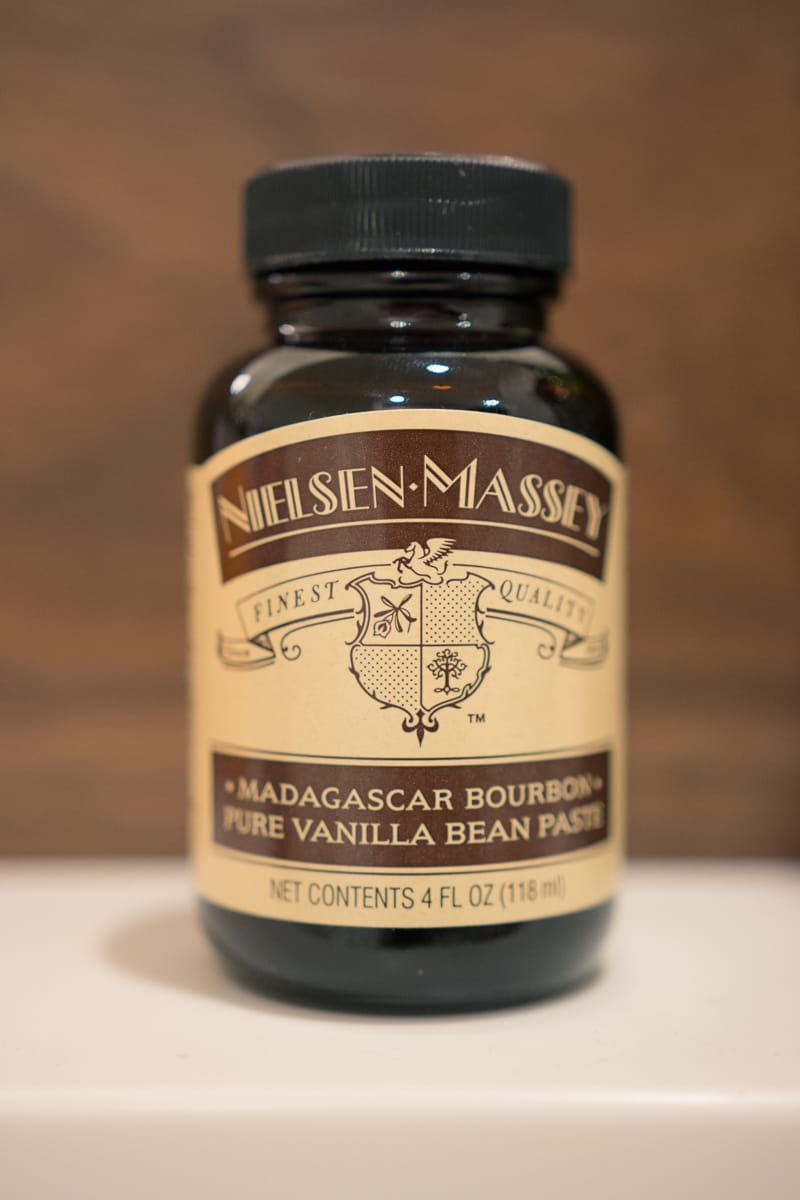
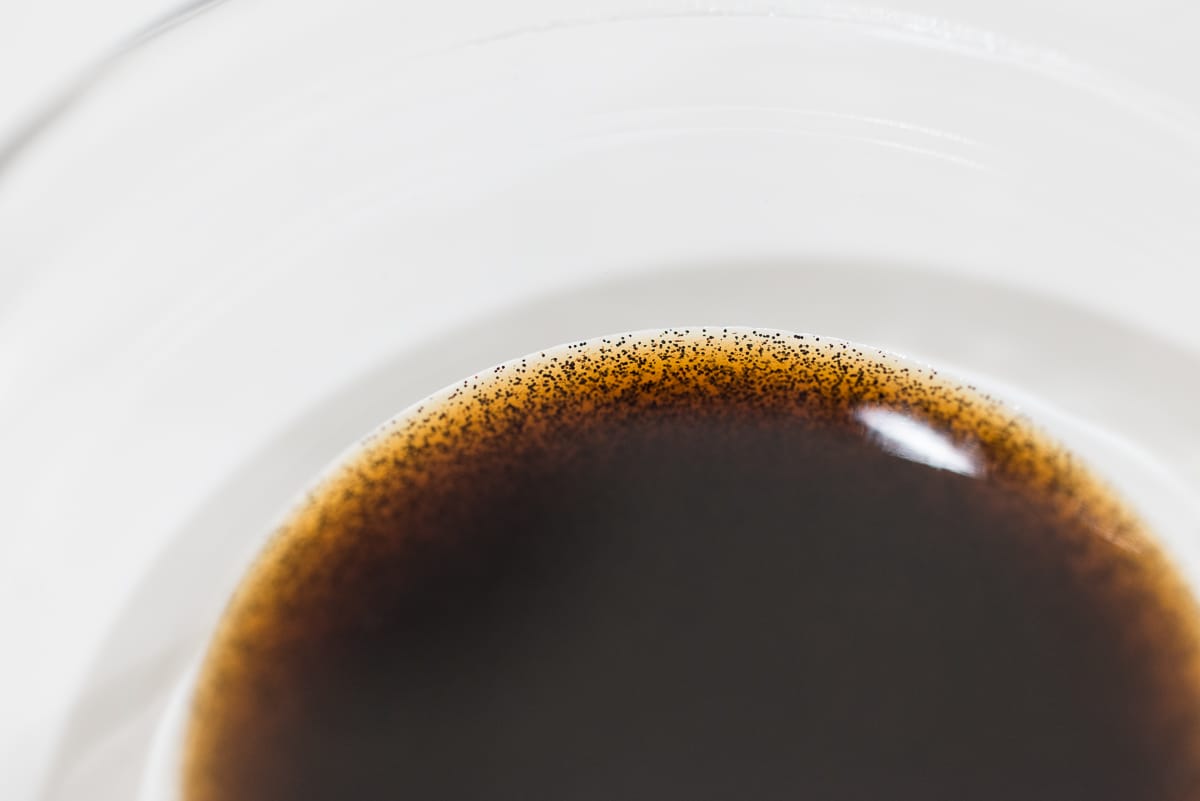
Fluffiness/texture
My recipe adds confectioner's sugar at the very end. This induces crystallization, making for a "short," tender texture (i.e., not cohesive or given to stringing when pulled), reminiscent of a sticky, highly-aerated fudge. Omitting the confectioner's sugar will make an end result that is more elastic and chewy.
Cocoa butter is also added, but it is optional. Omitting cocoa butter causes the nougat to be extremely adhesive and very difficult to work. You'll need lots of extra cornstarch. Addition of cocoa butter further shortens the texture, making it more tender and less chewy. It also imparts a pleasant subtle flavor, unsurprisingly reminiscent of white chocolate. I use much less cocoa butter than most recipes. I find that too much mottles the wafer paper and makes the nougat generally greasy. If you want more of the properties it imparts, you can safely as much as double the amount I call for, up to 50g.

Hardness
130° (soft) to 145° (medium-hard) is what I consider the safe range. Bear in mind that differences of only a couple of degrees will result in a discernible difference in the end product. The higher the temperature the sugar reaches, the less water the nougat will contain, making for a harder end result. Many recipes call for 155°, but I find that leads to a very hard and unsatisfyingly tacky result (to say nothing of its ill-effects one one's dentition). I opt for 135° in my recipe, but I have also been pleased with the results at 130°. If you want a more chewy, smooth confection, 145° is a great temperature.
Inclusions
Nougat de Montélimar is technically an AOC term, so you can't actually sell something called that unless it was made in a particular region in France. But if we wish to stick with the formal specs rather than the region requirements, it must contain 30% almonds or 28% almonds and 2% pistachios (see French Wikipedia). I prefer the purity of all almonds, but adding some pistachios is pretty and doesn't interfere with the flavor much. I have also, especially at the holidays, added a number of other inclusions for variety: from candied ginger to dried cranberries. Candied orange peel is a particular favorite of mine and complements the almond well. Experiment as you like.
The Detailed Recipe
Ingredients
- 425g raw skinless (blanched) almonds.
Swap out 125g of this (give or take) for pistachios if you like. - 50g fresh egg whites
- 10g albumen powder
- 30g granulated sugar
for egg whites - 120g glucose syrup
- 380g granulated sugar
for syrup - 100g water
- 230g honey
- 25g cocoa butter , melted
Optional - 40g vanilla bean paste
- 100g confectioner's sugar (10X)
Optional - other inclusions
Optional. Candied ginger or orange peel, dried cherries or cranberries, dried rose petals, etc. - 2 sheets wafer paper
- Cornstarch powder
as anti-stick coating for hands and tools
Directions
Note that many of these steps occur rapidly and in parallel, so it's best to go over all the steps in the recipe a few times before actually attempting it. A bit of fast-footwork choreography is involved. If all goes well, the cooking phase should only take a few minutes.
1.
With a hand whisk combine the 30g sugar, albumen powder, and fresh egg whites in mixer bowl, ensuring that any lumps have dissolved.
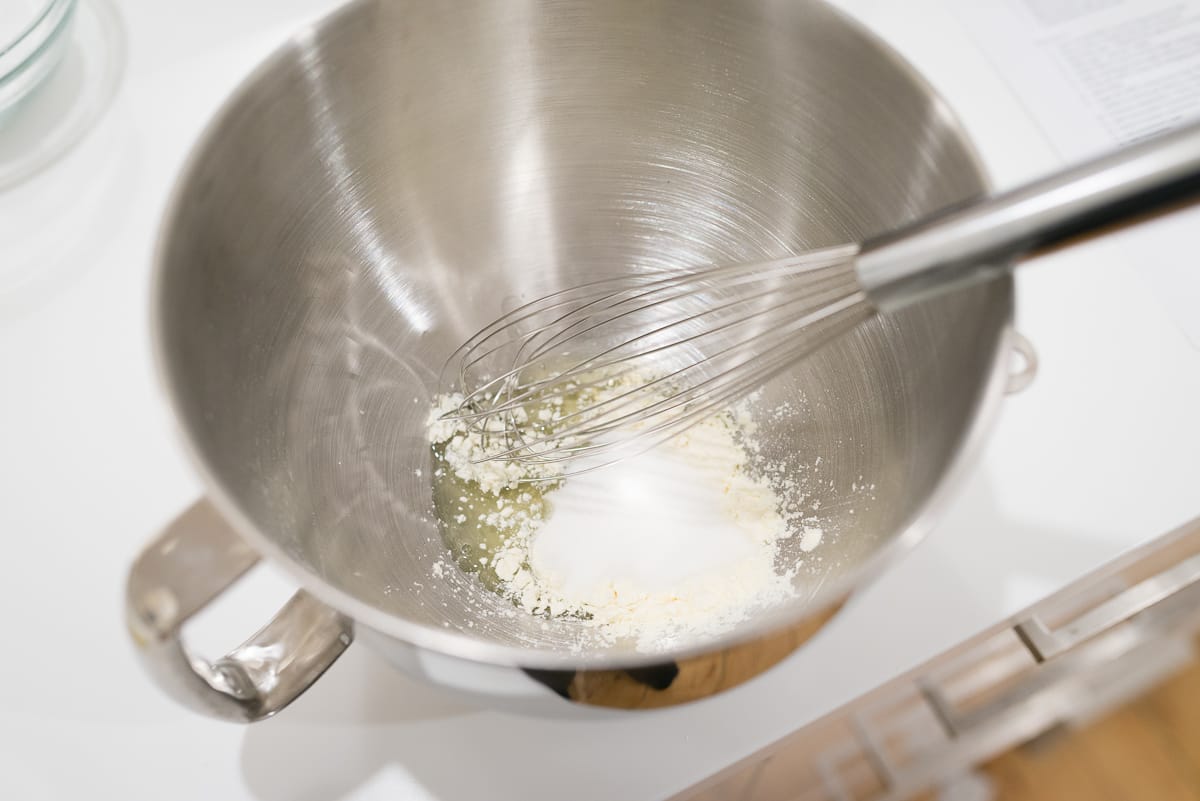
Fit the bowl into the mixer with its whisk attachment in place. Leave the mixture to sit while performing the other steps, allowing the dried albumen to re-hydrate.
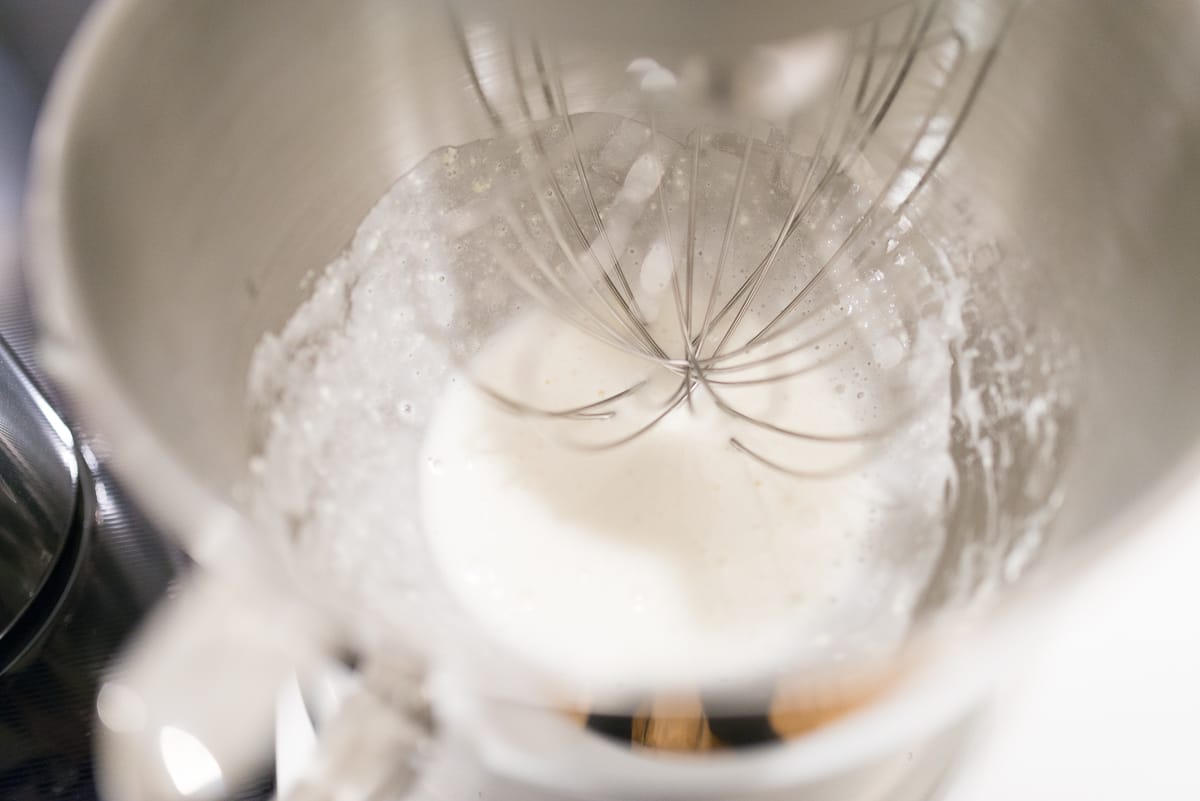
2.
Heat oven to 180° (350° F). Spread the nuts in a single layer on a quarter-size baking sheet or jelly roll pan , or the pan of a toaster oven. Roast for 12 minutes.
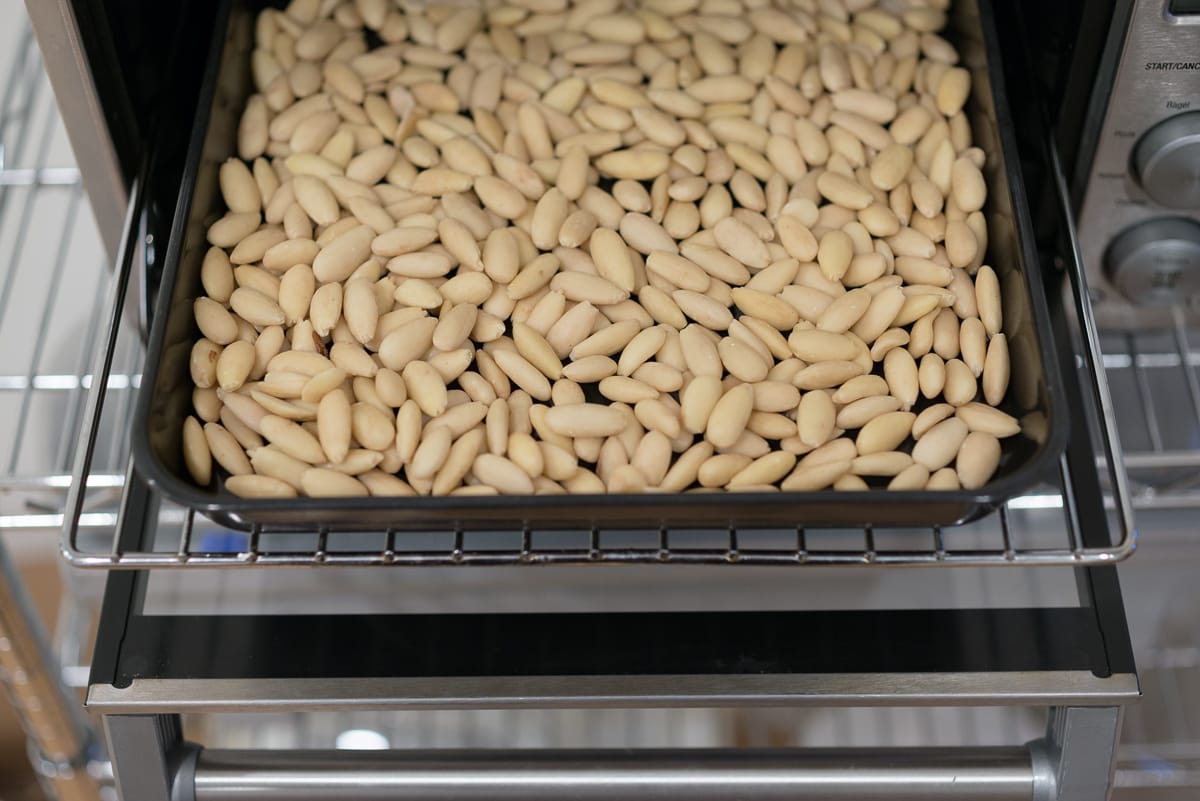
You don't want any burning or charring, but there will be a rapid and radical change in their aroma and flavor when they go from being raw to ready; I'm always impressed by how definitive a tipping point there is between these two states. The only way to know for sure that they are done is to cool one off and taste it. There should be no hint of rawness at all and only a gentle toasted flavor. The importance of this step can't be overstated; since nougat is so subtly flavored, the taste of the almonds is central to the confection. If you burn the almonds, start over.
Leave the nuts in the oven to be kept warm at 50° (120°F). This way they won't cool down the nougat too quickly when added, which means a bit of extra pliability time after the warm nougat has been removed from the bowl and is being flattened out.
3.
Mise en place the other ingredients while the nuts are roasting.
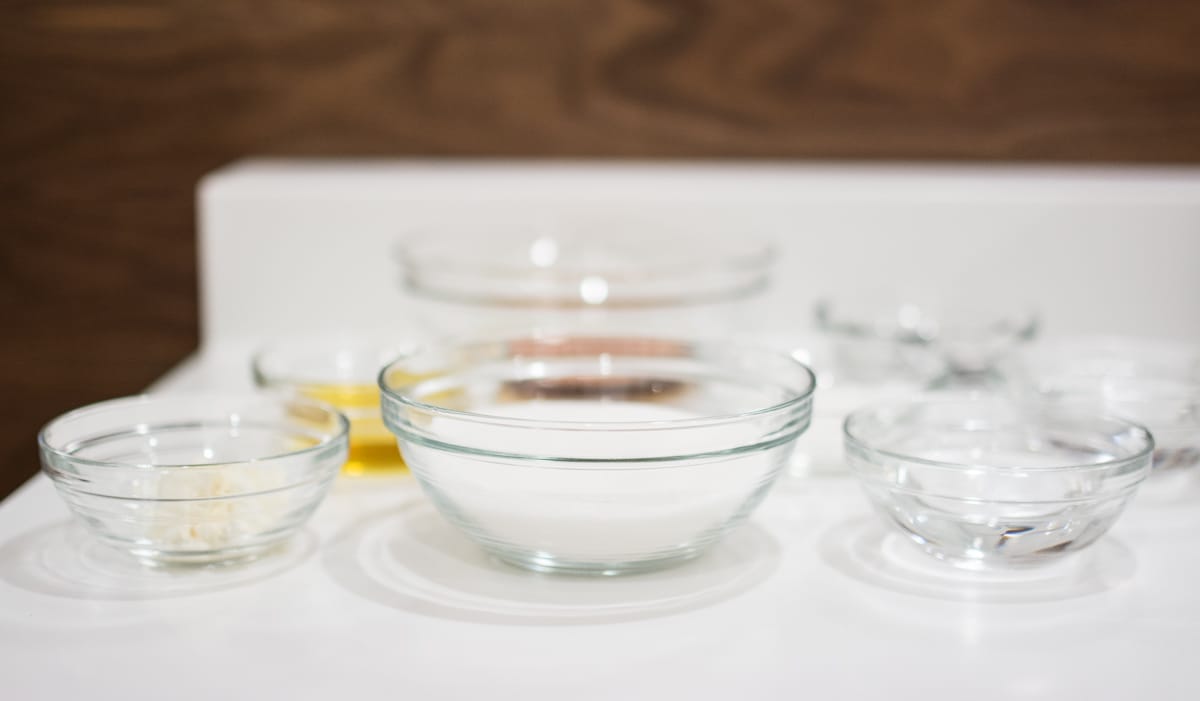
4.
Begin whipping the eggs at high speed in the stand mixer. You want somewhere between medium and firm peaks but not to go so far as stiff peaks. As soon as the eggs have begun whipping, move onto the next step. Keep an eye on the whites and only reduce the speed if they appear in danger of moving to stiff peaks as you perform the other steps below.
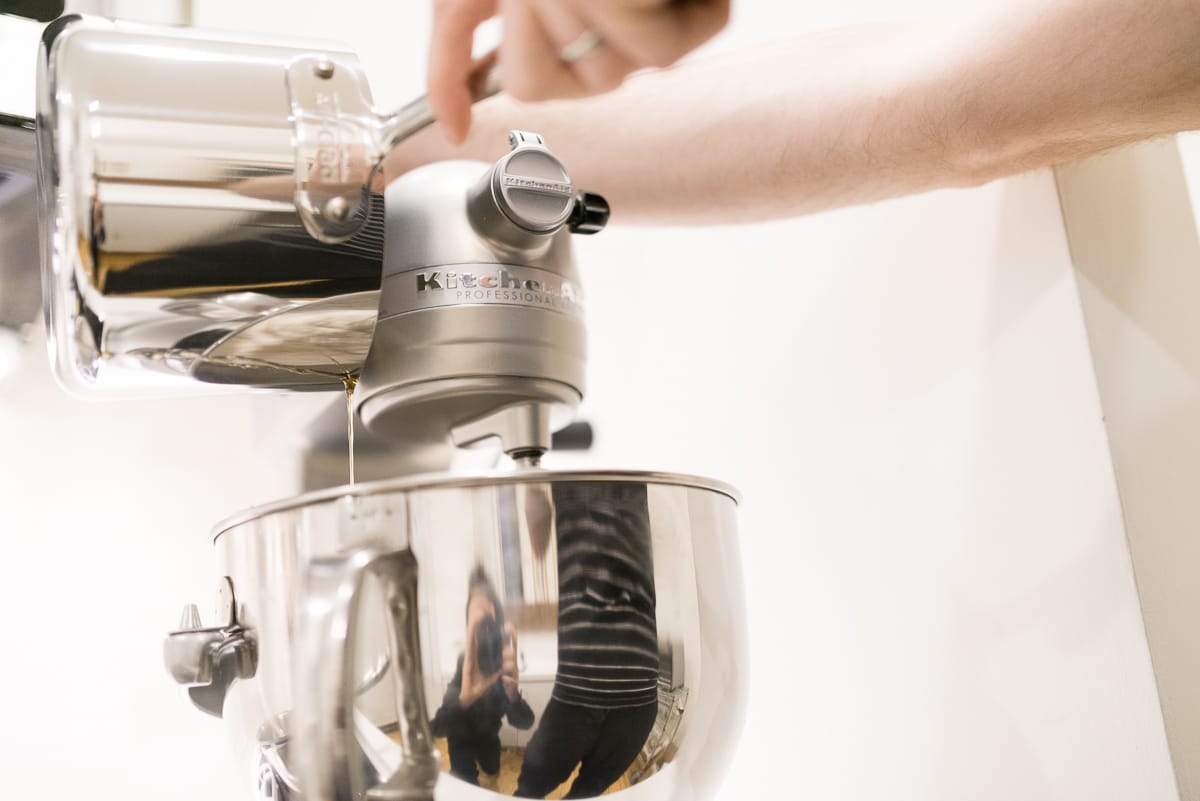
5.
Heat the honey on high.
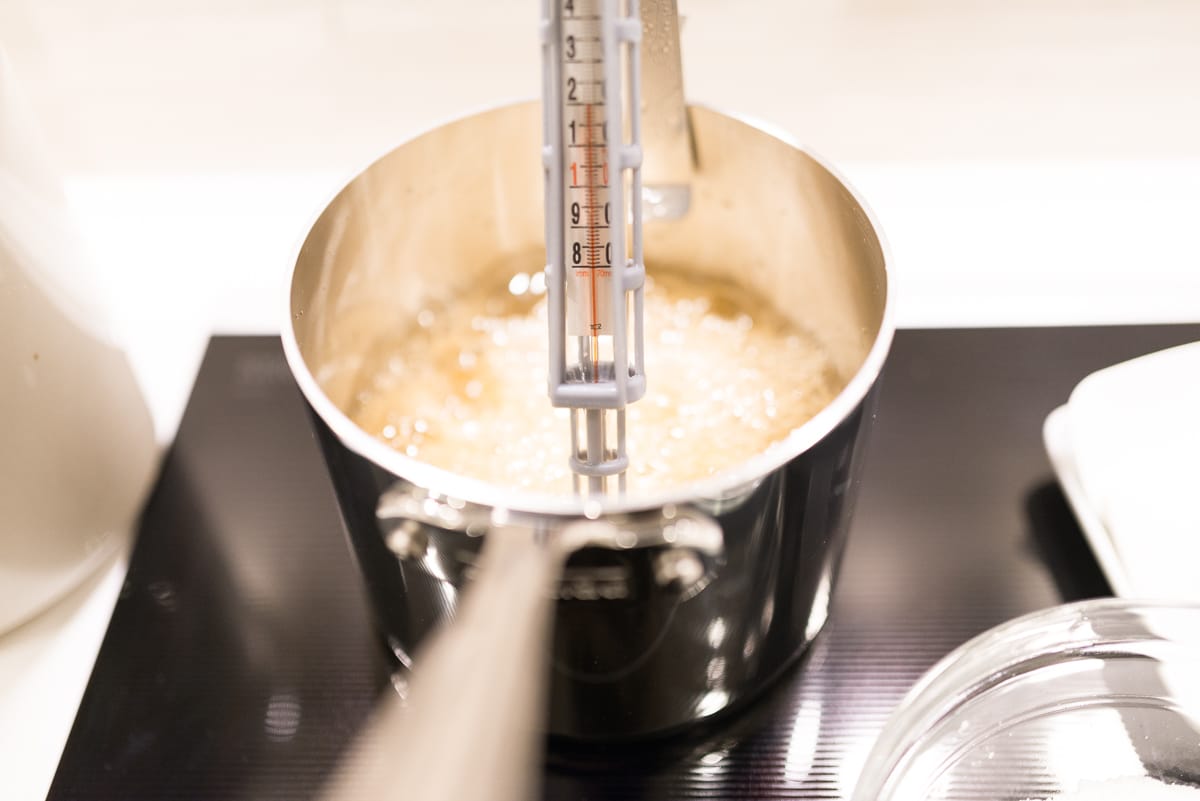
6.
When the honey has reached 120°, remove the honey immediately from heat, reduce mixer speed, and slowly stream the hot honey into the whipping egg whites, making sure not to add them so quickly that the egg whites collapse. Return mixer to high speed and continue to aerate the whites thoroughly.
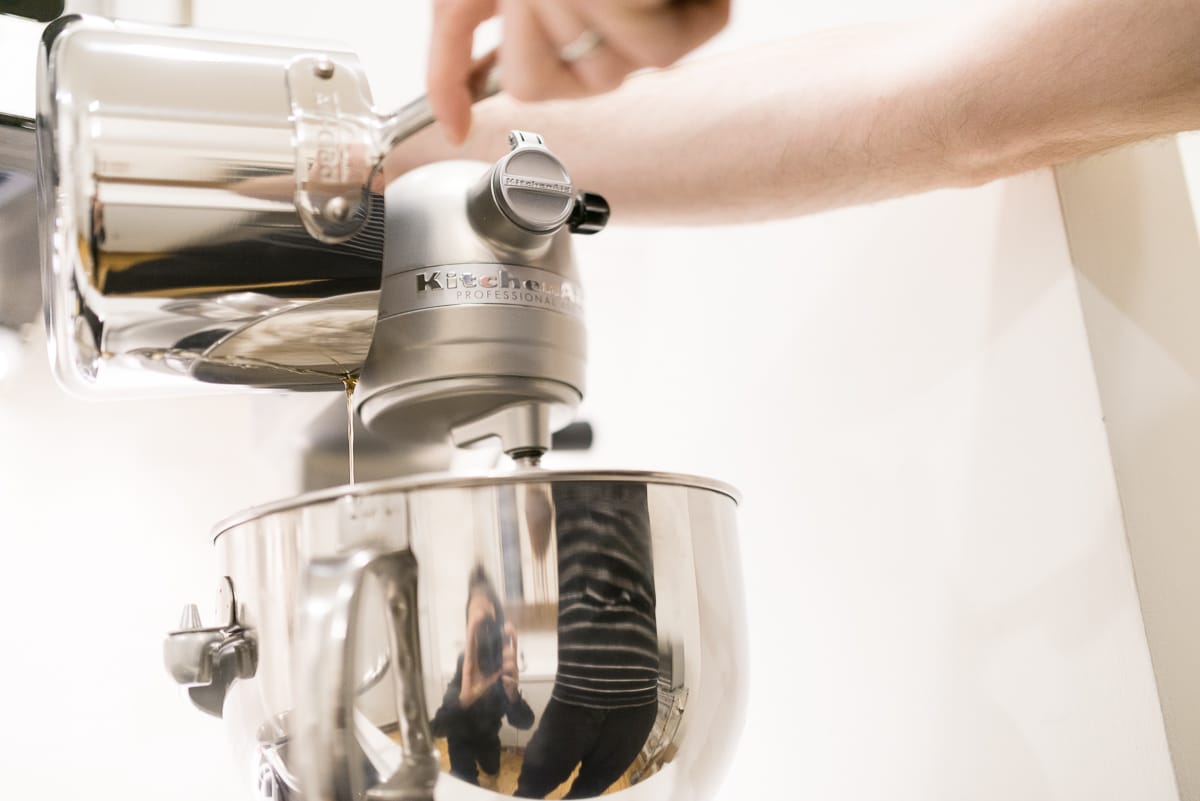
When adding the honey, ensure that that the mixer is operating at slow enough a speed as to avoid the honey being primarily spattered against the high walls of the bowl rather than being incorporated into the egg whites.
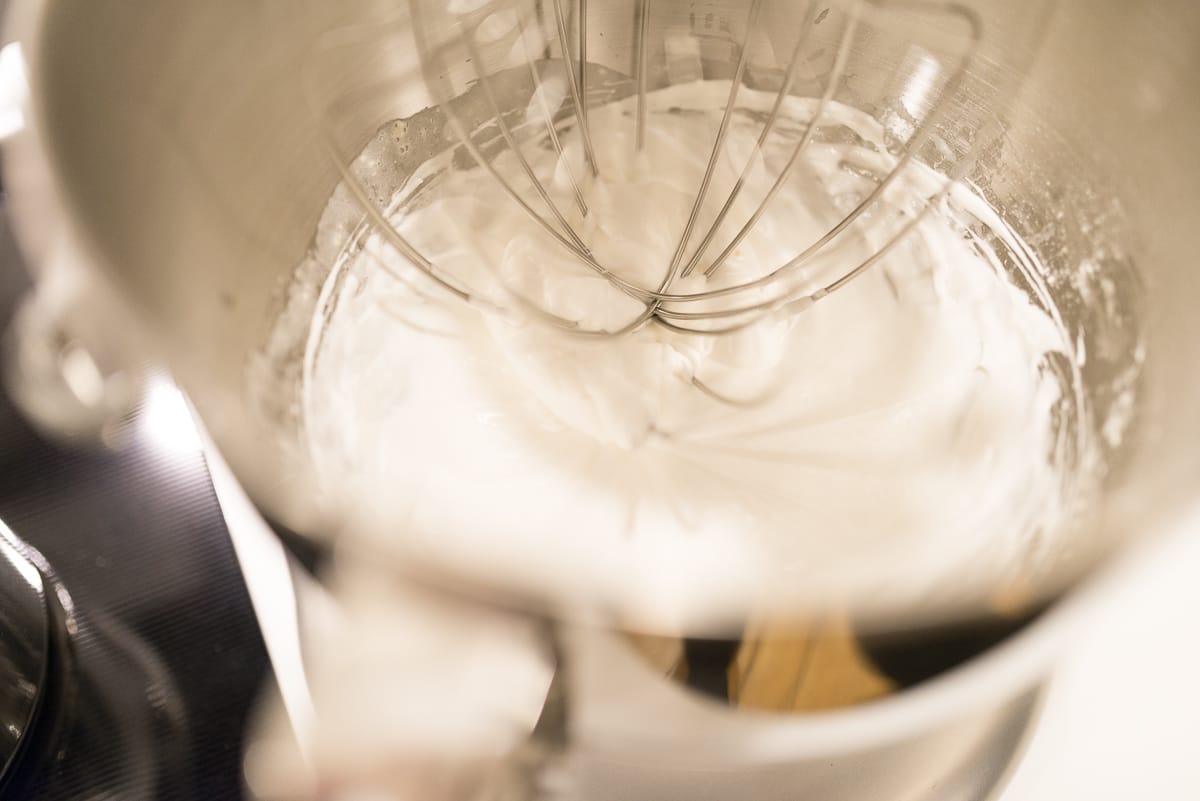
7.
As the honey is whipping into the whites, begin heating the 380g sugar, water, and glucose syrup on high.
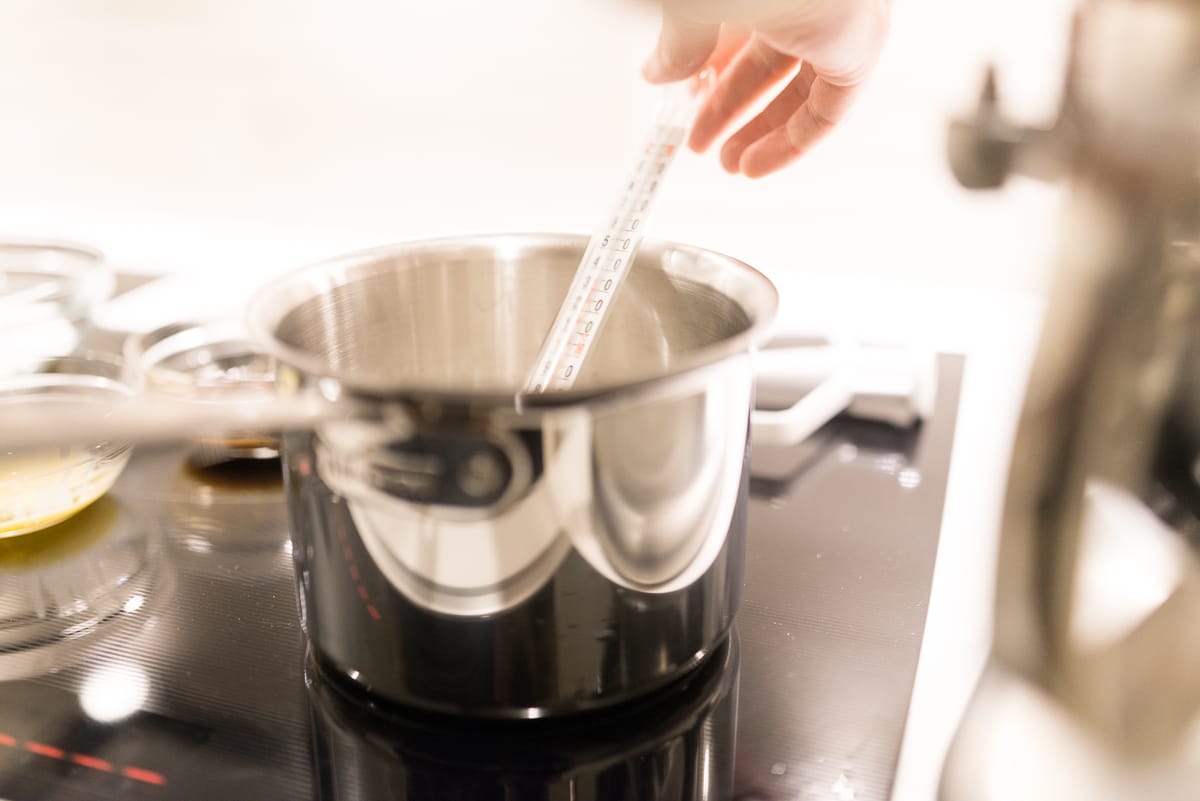
8.
At the precise moment when the thermometer on the cooking sugar mixture registers 135°, remove it from the heat and pour into the egg whites with the whisk attachment running at medium speed, as quickly as they will accept the sugar without collapsing (which would happen if you dumped it all in at once).
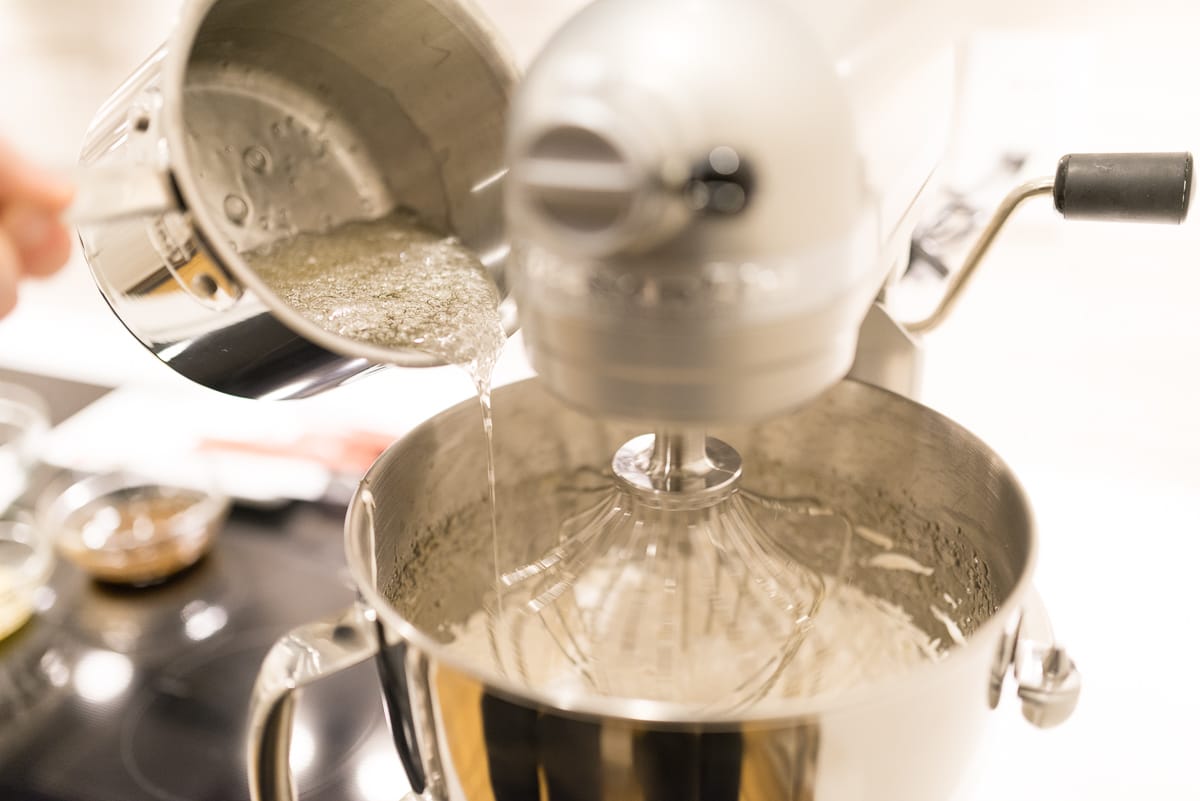
N.B. If you exceed the specified temperature, especially beyond 155°, your attempt is a failure and you might as well dump out the sugar mixture and try again. Heating to too high a temperature leads to nougat that looks fine at first but then after an hour or so hardens into an inedible tooth-busting brick—a sadistic sort of peanut brittle perversion.
9.
After the sugar mixture has been added, whip the nougat at high speed for about three minutes, allowing it to cool slightly and to increase in loft/volume.

10.
Add the vanilla paste. Beat just until it has incorporated and the nougat returns to a sticky consistency similar to before the vanilla was added.
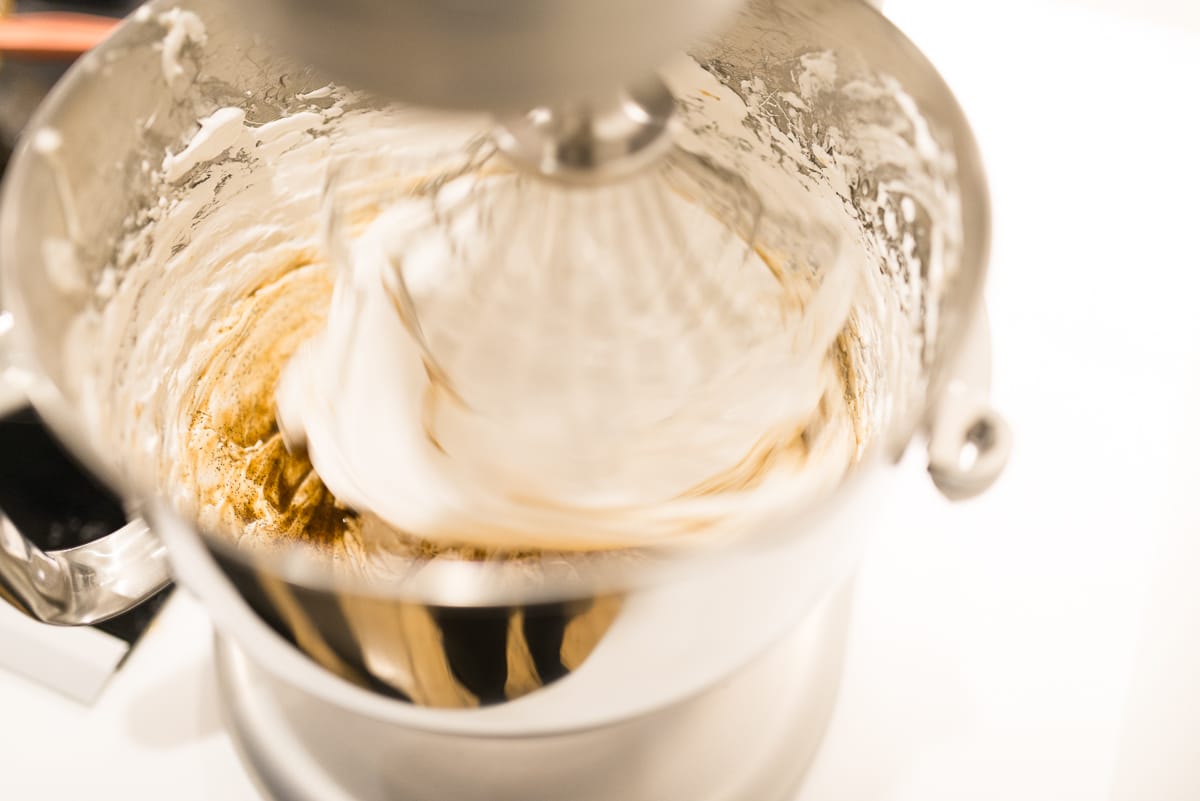
As soon as you add the vanilla, the nougat will flatten and become smooth, but do not fear: a few moments of whipping will return it to its original state.
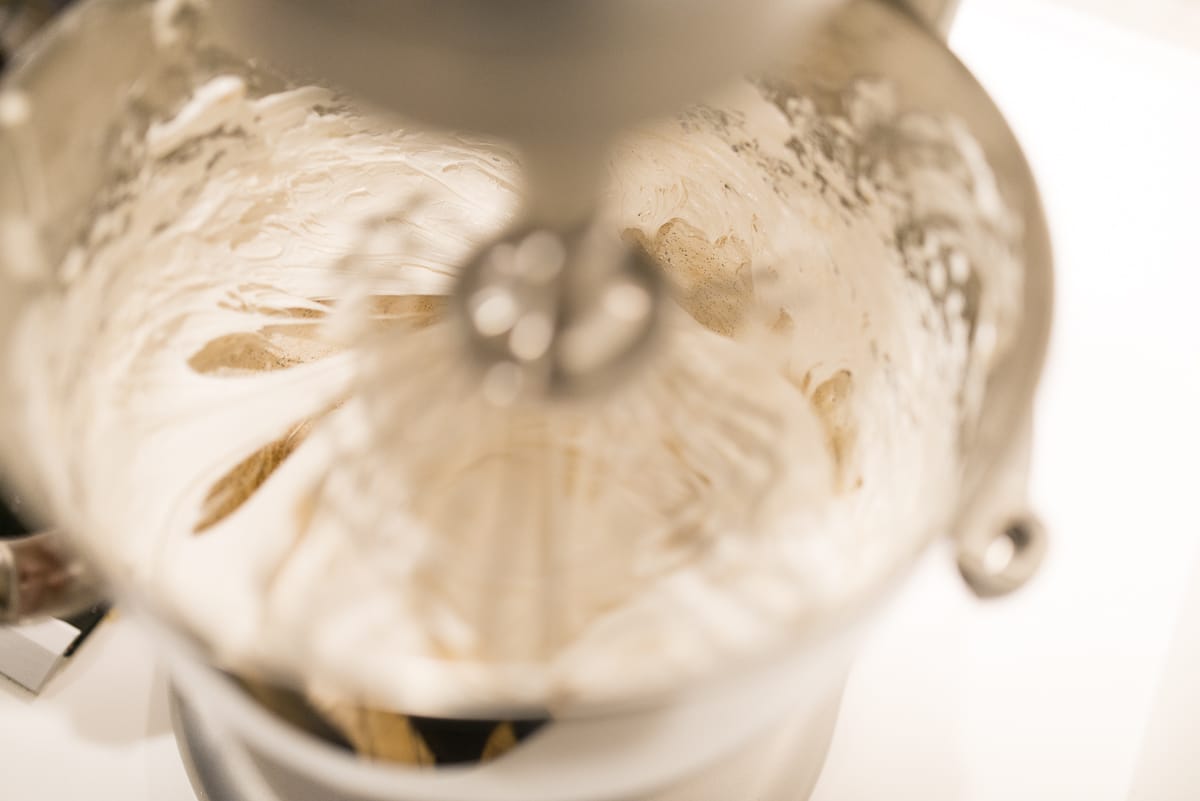
11.
Add the cocoa butter in small increments. As the cocoa butter incorporates, the nougat will become very lustrous and break into many small discrete strands. This looks bizarre and a little unsettling, but this is precisely what you're looking for. A few seconds after each addition of cocoa butter, the material will coalesce again in a fascinating, otherworldly manner.
If the nougat doesn't return to its former texture after the cocoa butter is added, heat mixer bowl with a propane torch while whipping. Keep the torch constantly in motion, however, as a brief pause will cause the nougat on the immediate other side of the bowl to scorch.
12.
Remove whisk and add beater attachment. Add the inclusions (almonds, etc.) and the confectioner's sugar. Pulse the beater attachment through the mixture a few times just to incorporate, something like for a single 360° rotation in a few tiny steps. (You want to avoid pulverizing the nuts.)

13.
Remove the bowl from the mixer. You should, if you're careful of the temperature of the nougat, be able to remove the excess candy from the wires of the whisk with your fingers (coated in corn starch) and/or a silicone spatula.
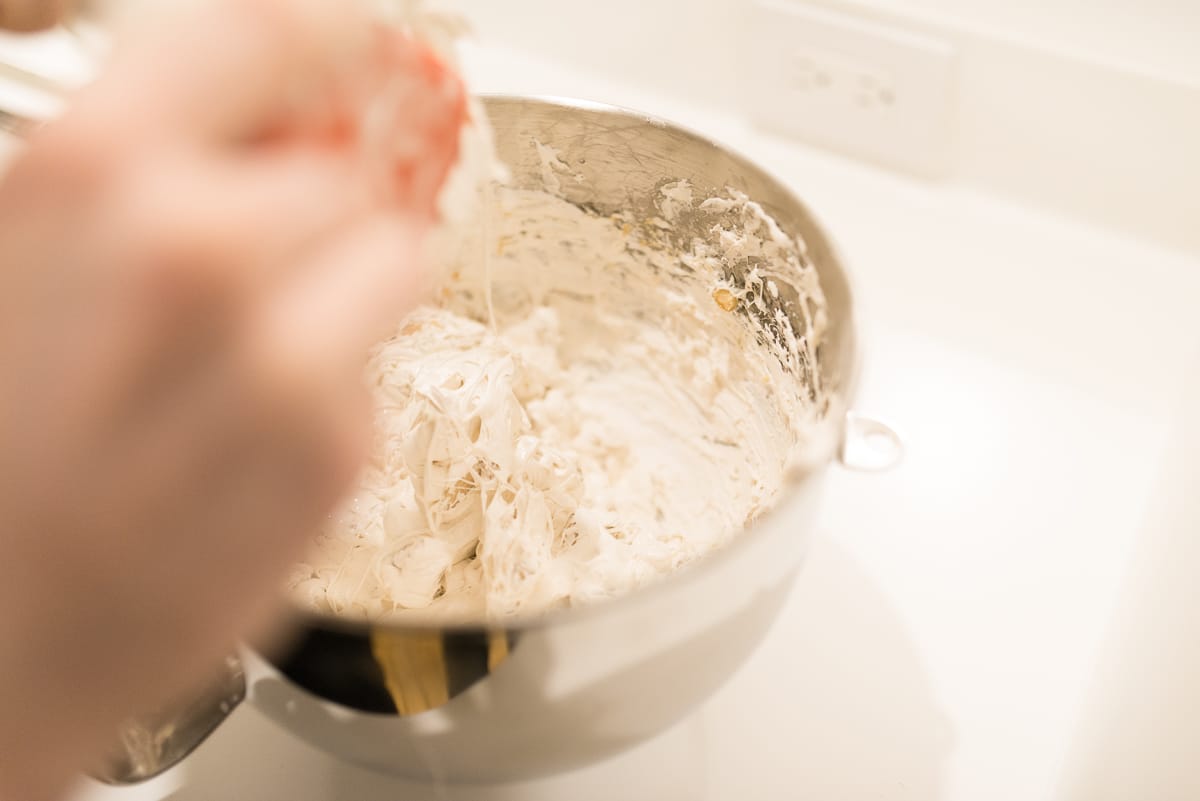
14.
Moving quickly, scrape the nougat out onto the prepared wafer paper on the cutting board, flattening it into a sheet.
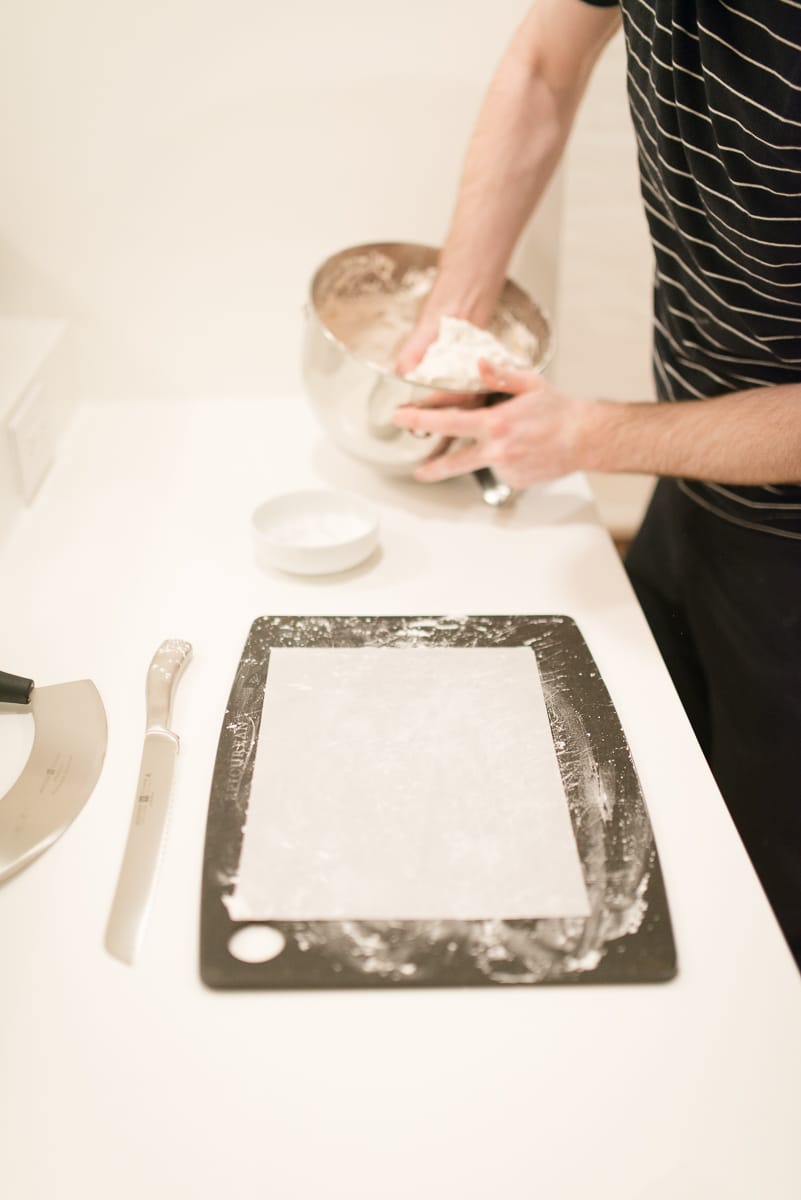


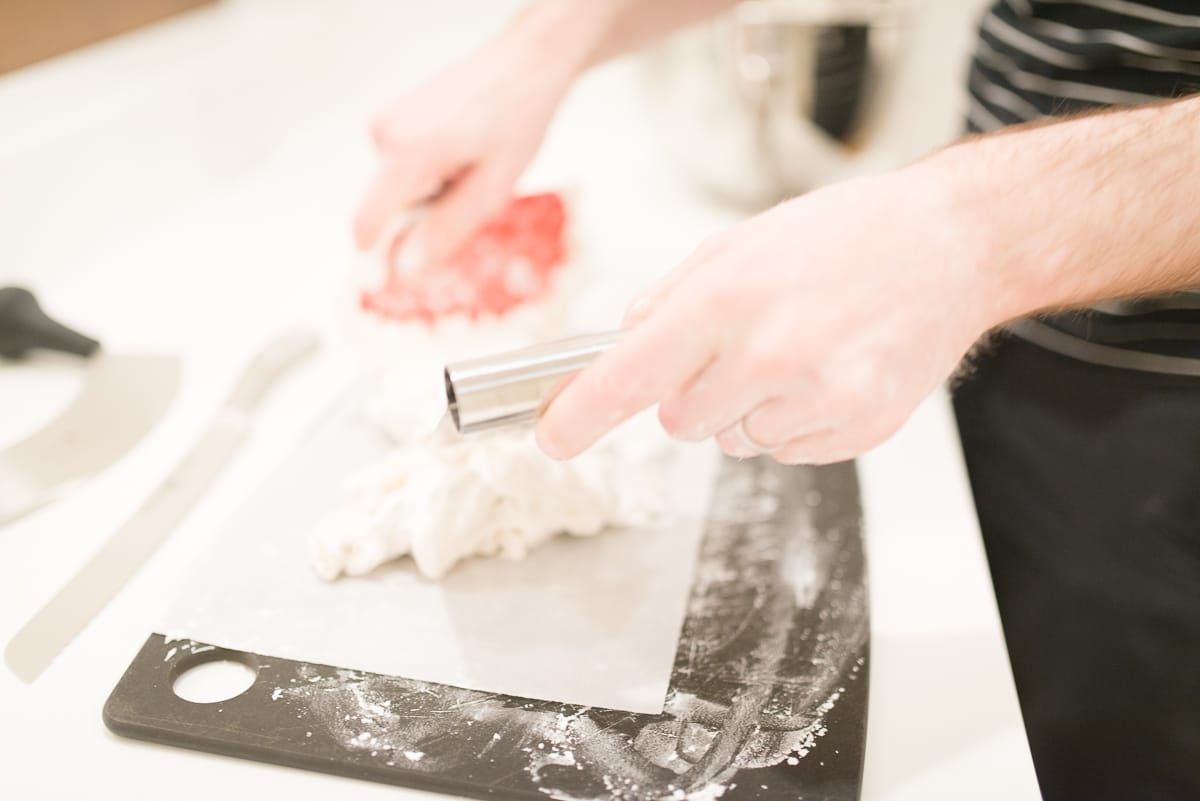

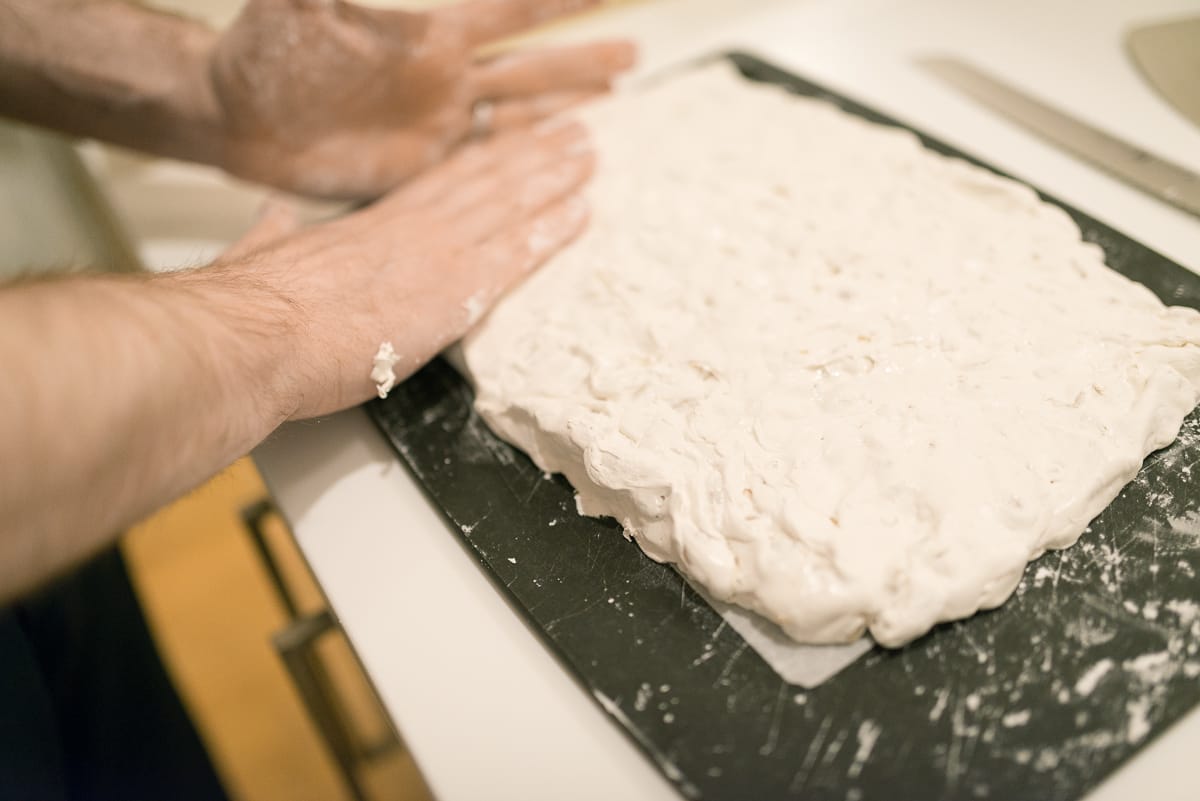
15.
Add second sheet of wafer paper to top, gently roll it to affix to the nougat surface, and square off edges as best as possible, first by molding with your fingers and then by cutting with a knife.

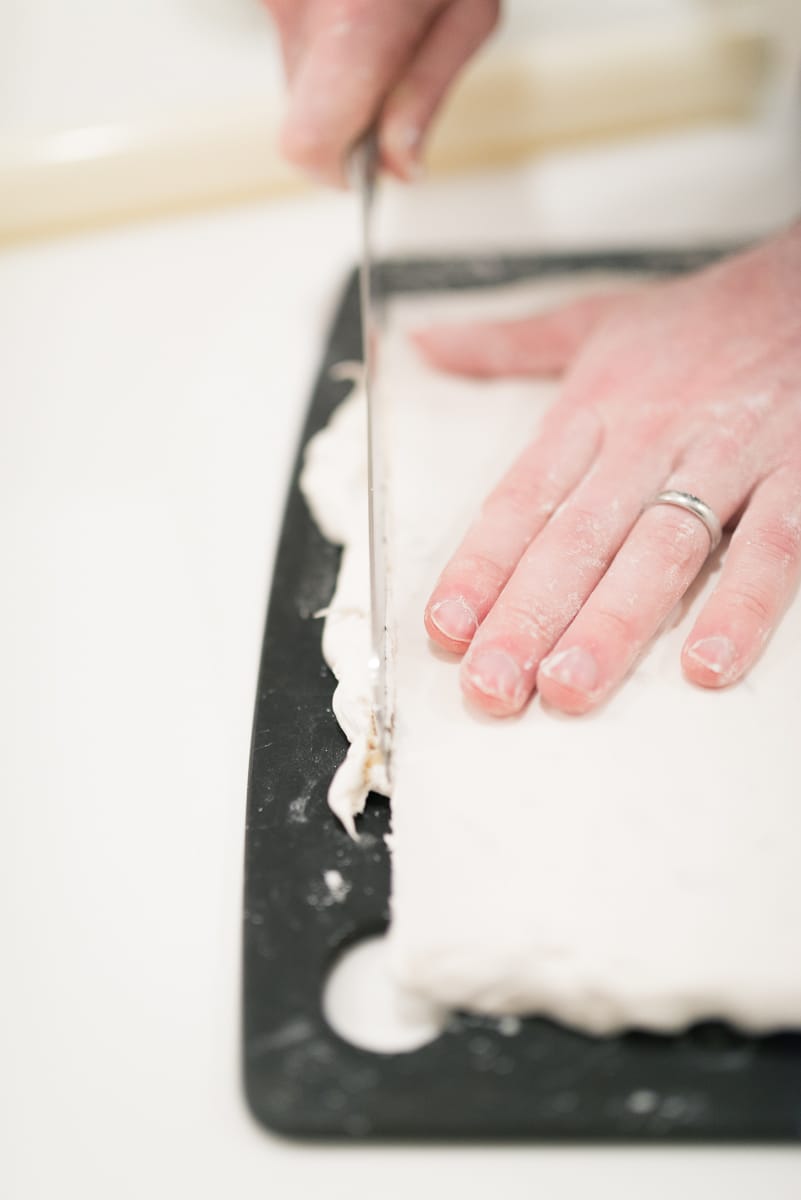
16.
Allow to cool and set up for at least an hour or two, or overnight.
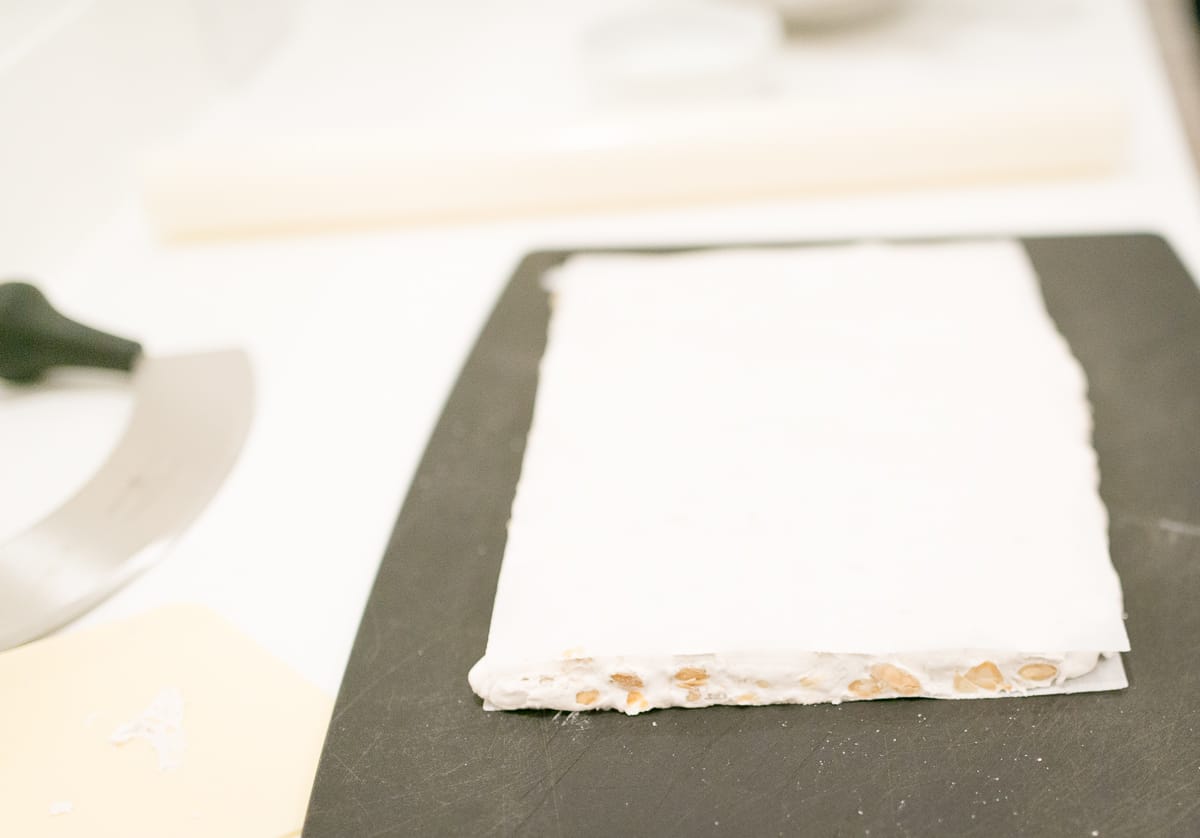
17.
Cut the nougat as you see fit. A traditional approach is long strips divided into smaller bite-size chunks.
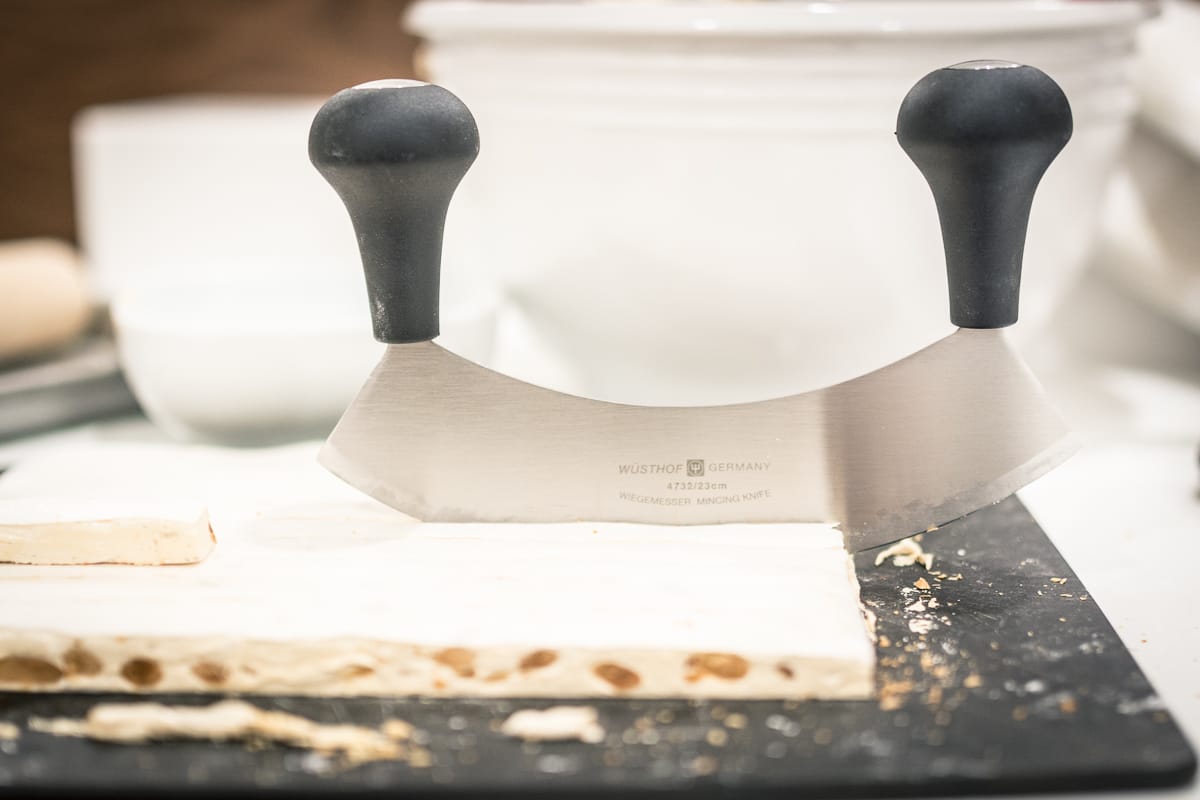
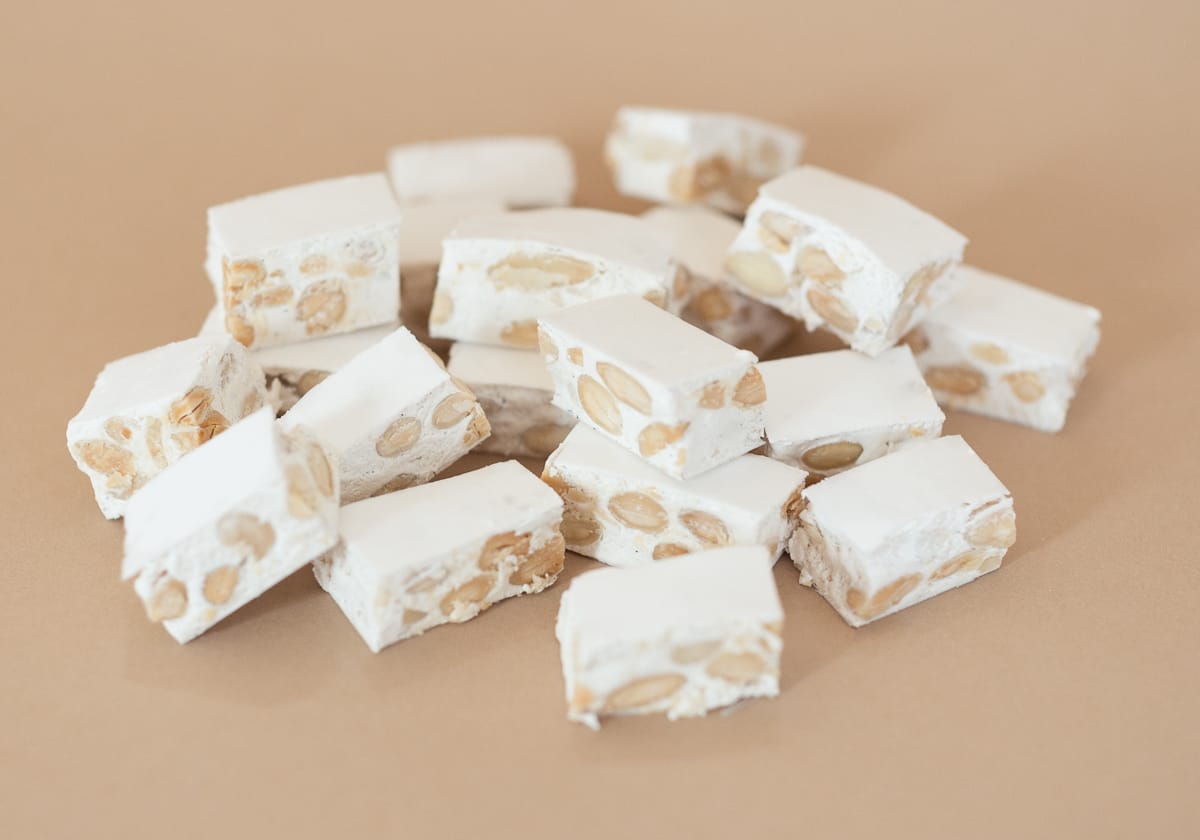
Tips and Tricks
Viscosity control
Both the honey and glucose syrup are quite viscous and sticky. This can be greatly mitigated in three ways:
- Avoid transferring vessels (see below)
- When you are measuring a syrup into a mise en place bowl, wipe it gently with a paper towel saturated with vegetable oil. This will help the syrup slide out of the bowl when needed.
- Most importantly, you can heat your glucose syrup and honey for a few seconds (10-30) in the microwave, which will make it much easier to pour.
Measurement
Since the honey is quite viscous (making it difficult to move between vessels) and is cooked by itself, it is easiest simply to tare the scale with one of the saucepans and measure the warmed honey directly into it.
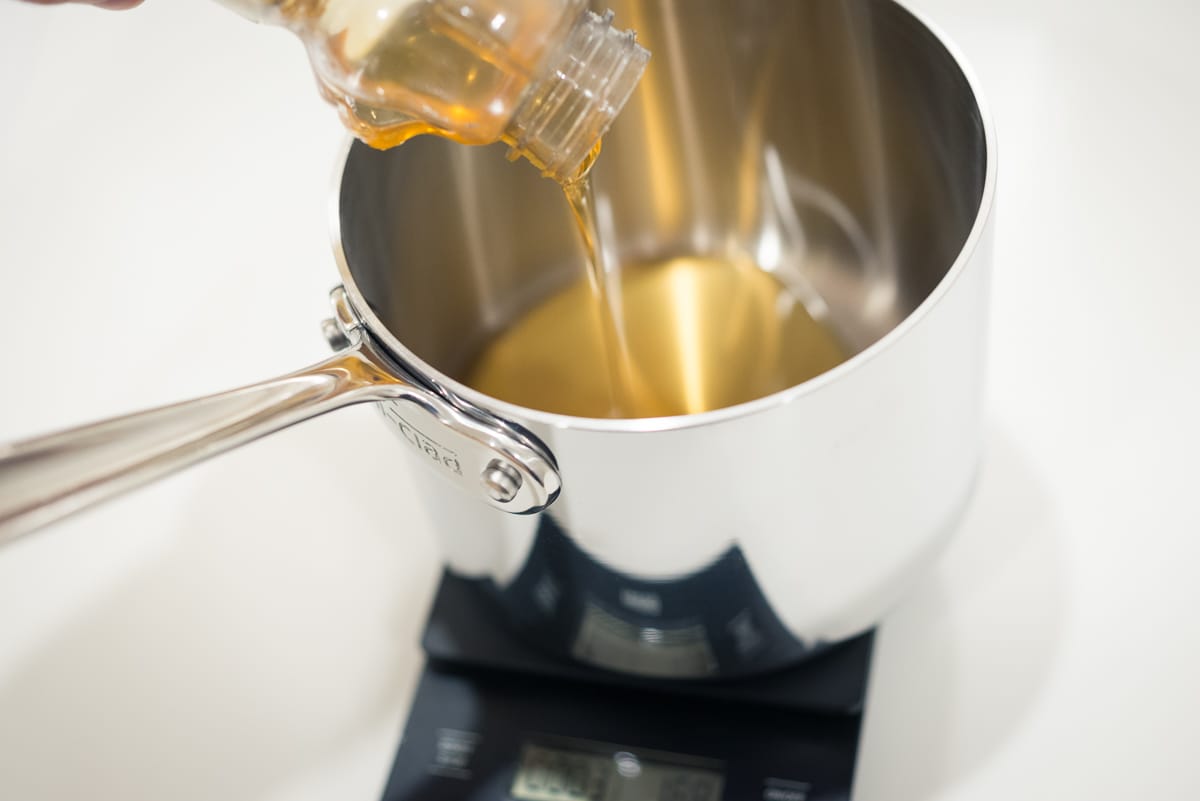
As above with the honey, you can measure the egg ingredients directly into the mixer bowl (after taring out the scale to the bowl's weight). If weight everything together like this, the cumulative weight increments for the sugar (30g), albumen powder (10g), and fresh egg whites (50g) are: 30g, 40g, and 90g, respectively.
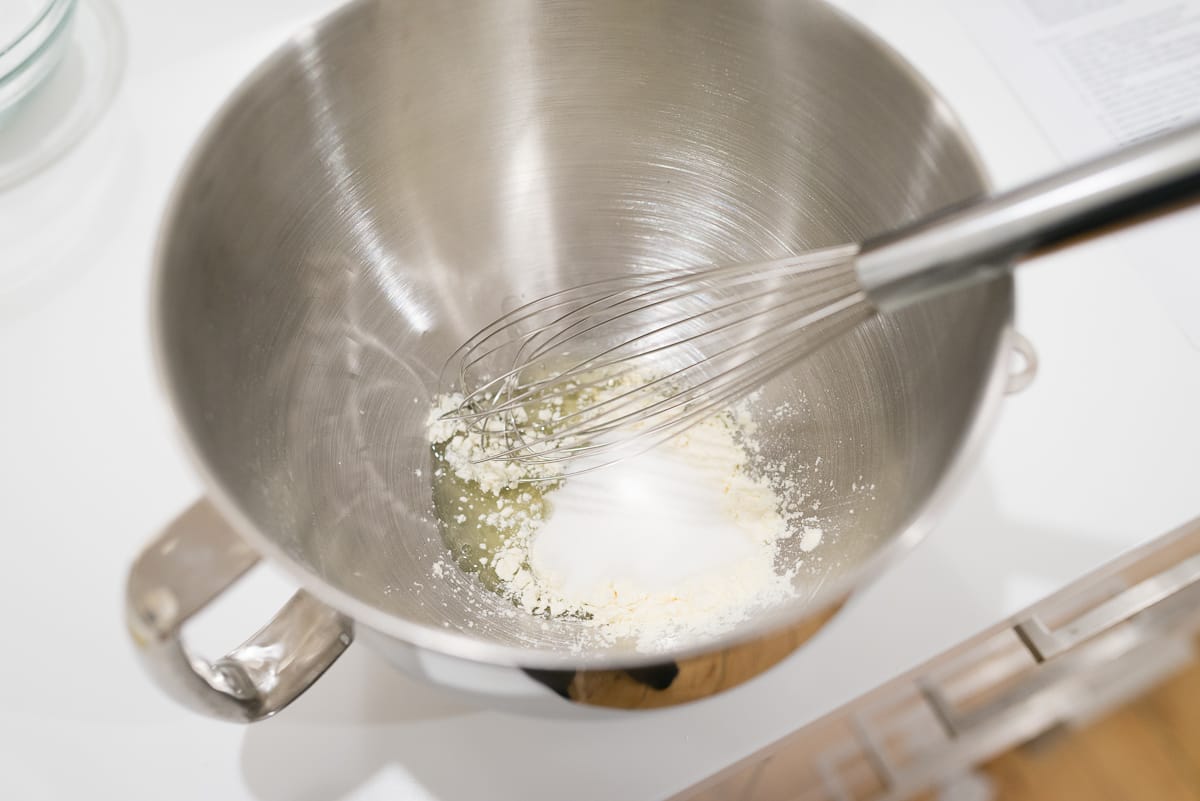
The same could surely also be done with the glucose syrup (120g), sugar (380g) and water (100g). The cumulative increments are: 120g, 500g, and 600g, respectively.
Cocoa butter
Cocoa butter is easily melted in the microwave. It comes in pistoles, which are easy to measure out.
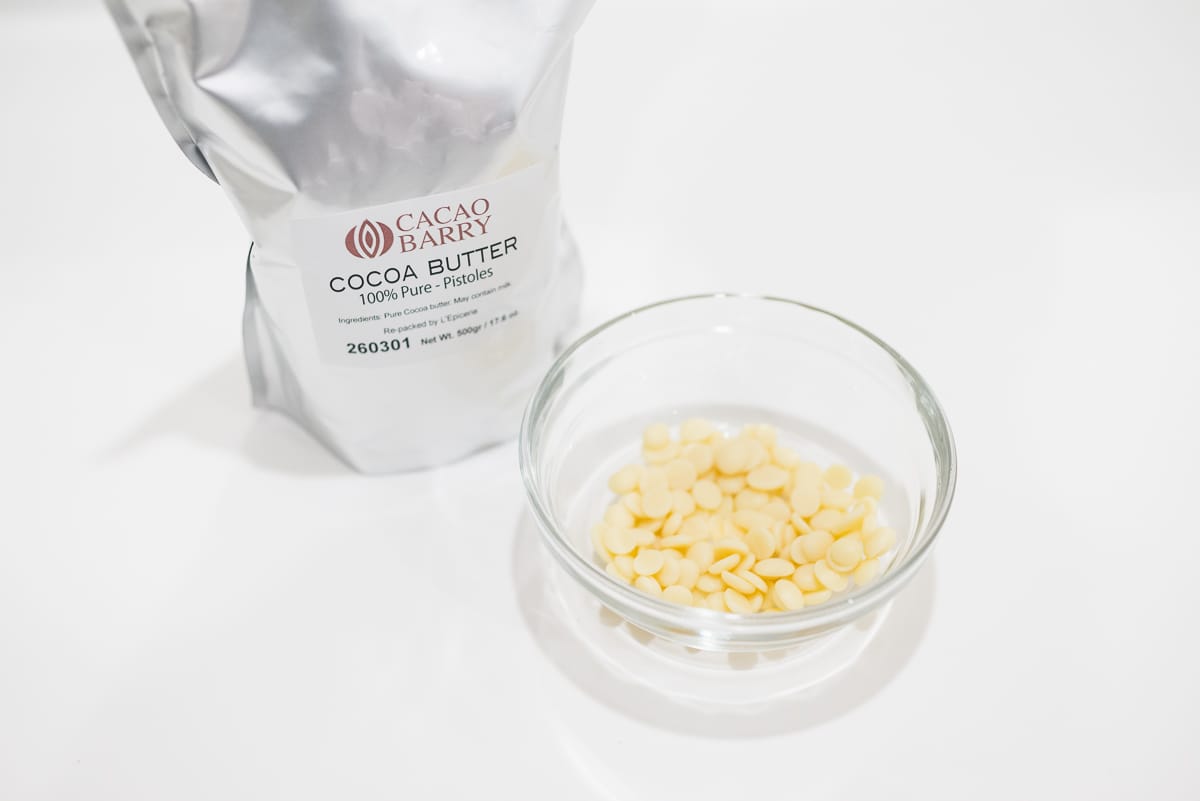
It also comes in solid form. If you opt for this version, you'll find it easier to portion if you use a chocolate fork.
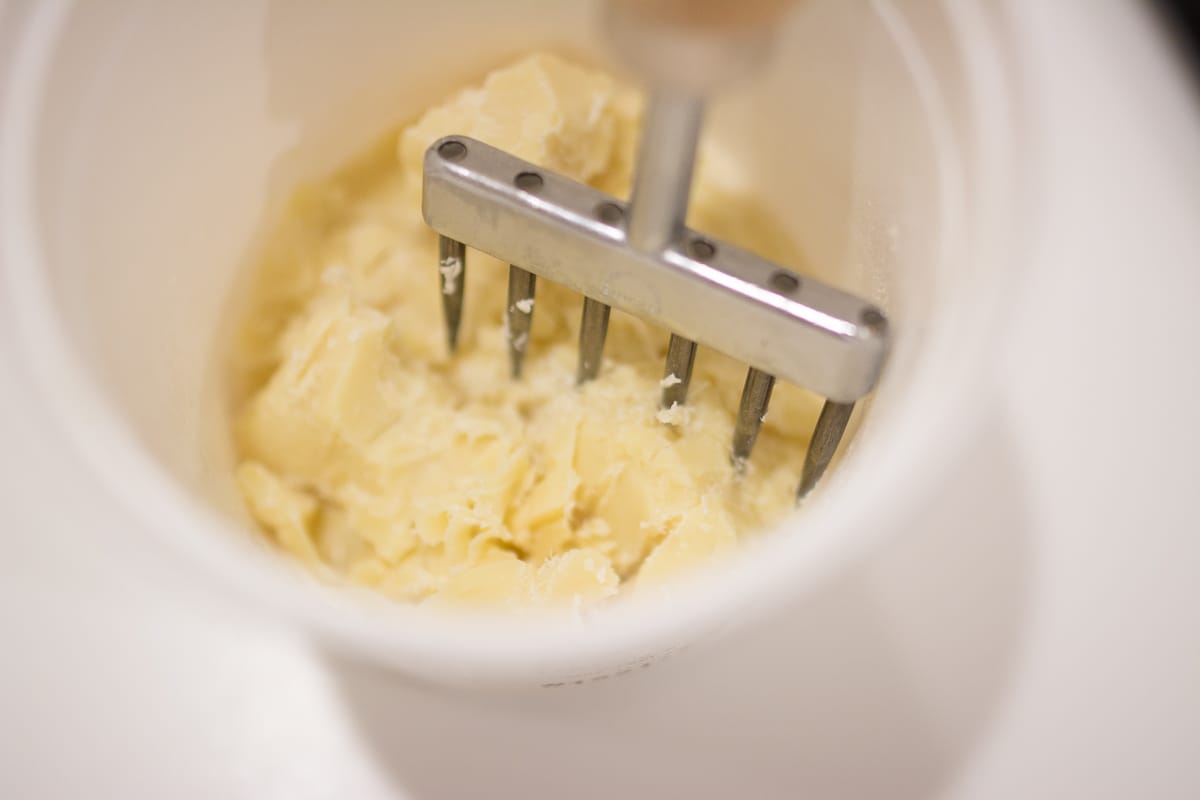
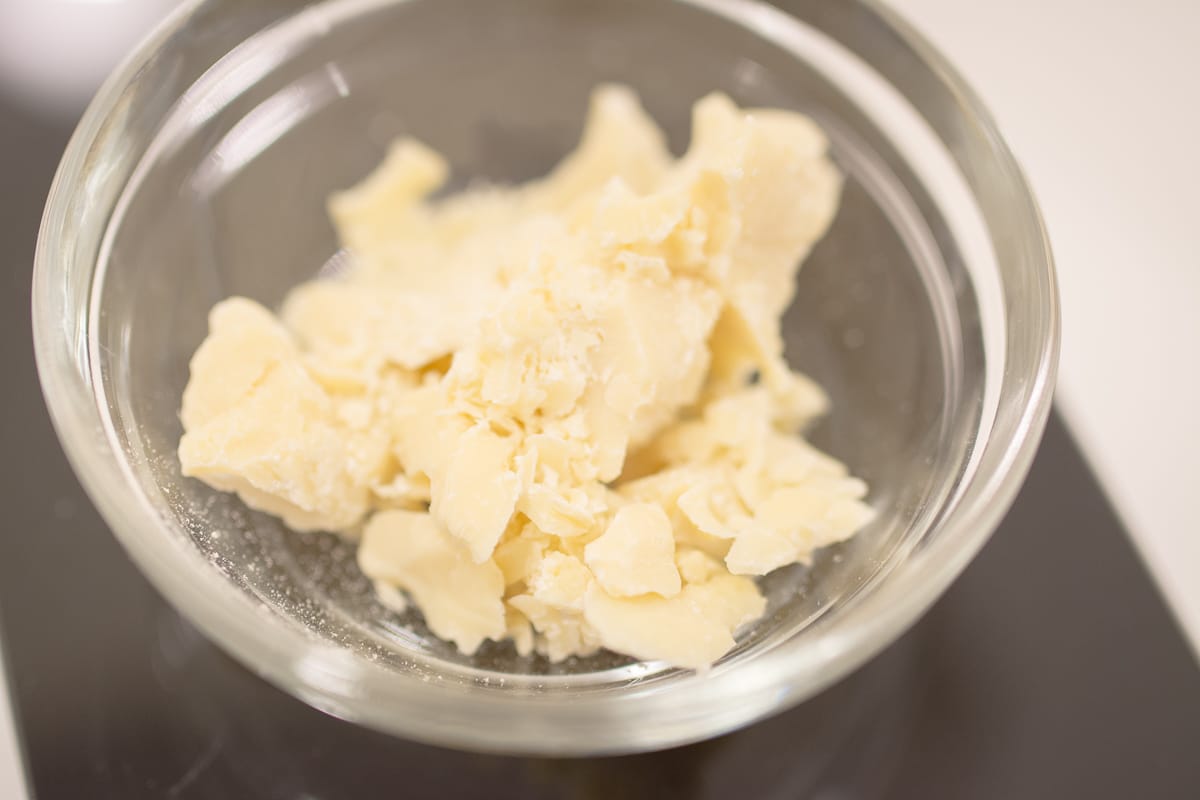
Cleanup
Toss everything in the dishwasher without fear. The nougat encrustations on your utensils and pots may look daunting, but the warm water in the dishwasher will dissolve it all completely.
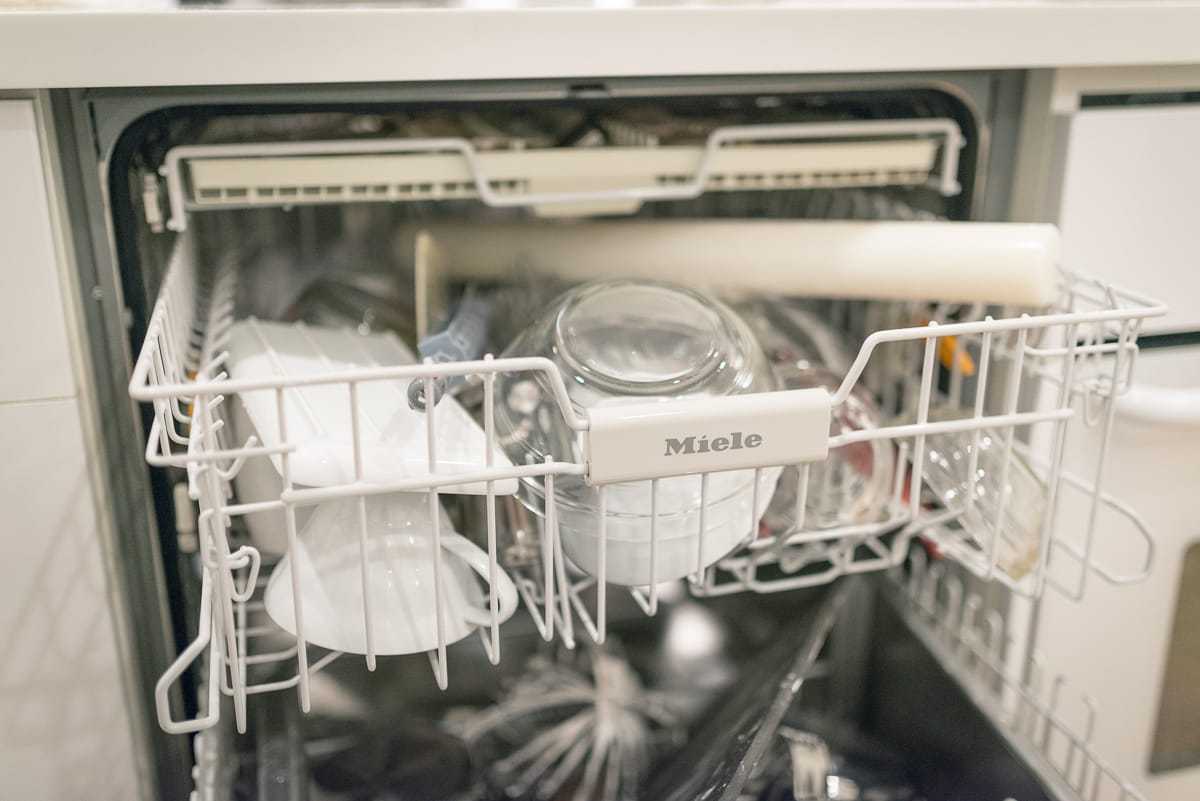
Cheat Sheet
Below is a printable short-form cheat sheet recipe for those have mastered the full version recipe